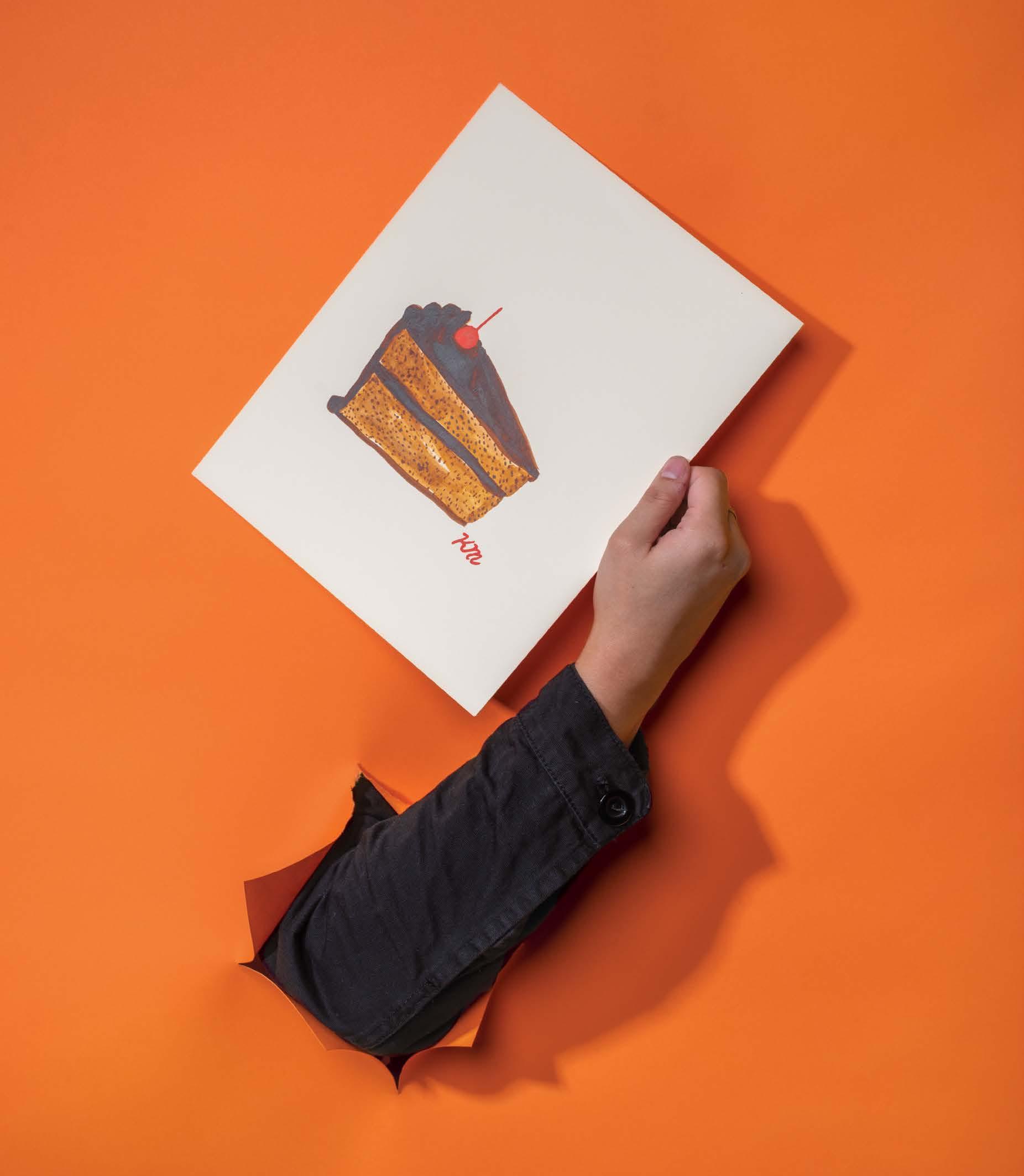

baunfire.com/careers




baunfire.com/careers

Nov / Dec 2019
Cultivator
Daniel Garcia
Editors
Elizabeth Sullivan, Rah Riley
Samantha Tack, Linnea Fleming
Yale Wyatt, Grace Olivieri
Community Partnerships
Kristen Pfund
Photographers
Avni Levy, Sannie Celeridad
Stanley Olszewski, Leopoldo Macaya
Polaroid Jay, Ngozi Harrison
Gege Xu, Arabela Espinoza
Phil Emerson
Writers
Brandon E. Roos, Nathan Zanon
Gillian Claus, Daniel Codella
Esther Young, Michelle Runde
Johanna Hickle, Grace Talice Lee
Yale Wyatt, Demone Carter
Brad Sanzenbacher, Kevin Marks
Publisher SVCreates
It shouldn’t surprise me that we could have titled this issue “Team” rather than “Dine.” Food and dining are intrinsically tied to relationships. And this being one of the most expensive regions in the world, partnerships have become an effective way to make an entrepreneurial dream a reality. We didn’t realize that these food-based features were all cofounded endeavors. This unplanned discovery amplifies our intentions of having a “dining” theme for our “Holiday Issue” as food sets the backdrop for community. These stories beautifully illustrate that connection.
We hope that you are encouraged to gather your team of friends and family to experience the food and talent offered in this issue. We think there is a little something for everyone’s appetite and believe this issue will make you hungry and even give you the munchies. Happy Holidays. May you and your family celebrate life and each other as you DINE.
Enjoy.
Daniel Garcia THE CULTIVATOR
10th Street Distillery | Braise Restaurant and Bar | Amanda Payne | Tōno Coffee Project
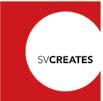

works is your community art and performance center

more than 100 works from emerging and established regional artists

free opening reception: november 1, 7–10pm free exhibition: november 2–december 7, 2019 hours: fri noon–6pm; sat/sun noon–4pm auction night: saturday, december 7: party 6pm, auction 7pm, just $20 registration the most accessible art auction in the region! collecting art exhibits your humanity!
works/san josé, 365 south market street, www.workssanjose.org facebook, twitter, instagram: workssanjose







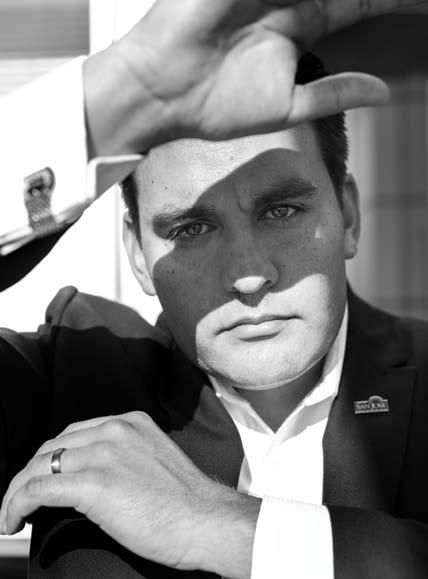






“That’s the jazz influence; I’m trying to sing it a new way each time, engage people differently. Make people think. We care about that.”
–Rachel Spung

Written by Esther Young
Photography by Leopoldo Macaya
soundcloud.com/achelpung
Social media: thesoulservice (Band)
rachelspung (Rachel Spung)
brenda_beane (Brandon Earley)
alonsosmusic (Alonso Sanchez)
dandan1790 (Daniel Williams)
Hailing from Monterey and San Jose, Rachel and the Soul Service deliver sparkling musical freshness—a groovy yet unprocessed blend of soul and R&B. The group’s tight chemistry is the clearest quality of their performance, resulting in a unity of sounds that comes across as fun, entertaining, and constantly innovating.
Rachel, how did you find your sound as a singer? RACHEL SPUNG : Growing up, I played classical French horn for seven years. At 15 I started playing guitar. Then I started my own rock band in my hometown, Monterey. I was in that band for two to three years, and I always wrote for other people to sing.
I feel like rock music is easiest to write and play when you’re just starting out. Eventually, I wasn’t into writing rock music anymore. I’d always been influenced by soul and R&B music.
How did this group get started? BRANDON EARLEY: After her band broke up, we started writing, just the two of us. ALONSO SANCHEZ: My other group had a last minute gig, and we needed an opening band. I met Rachel through a mutual friend, but she needed a bass player, so I decided I’d be the bass. Then I brought in Daniel because we’re both in the SJSU jazz program. RS: In the beginning, I’d ask Alonso, “What connections do you have?” I didn’t have any in San Jose. And here in San Jose there’s a lot more openness for younger-generation musicians. AS: I had another group prior and knew a lot of places to play. Eventually, I emailed the Come Up and almost every gig in San Jose is thanks to them.
What do you each bring to the sound of Rachel Spung and the Soul Service? BE: I really like heavy music and lots of unison between guitar and bass. Sometimes we’ll be playing the same line, and it sounds really fat and thick. Then we split off. I like varying that in whatever way we can. DANIEL WILLIAMS: I think the real keen listener will be able to hear our influences if they listen to the same kind of music. They’ll hear that melody quoted from this artist, that chord progression sounding like that song, or the way Rachel sings reminding them of their
favorite singer. RS: What I appreciate about Daniel is when he came into the band, he brought out the genre of music I fell in love with on my own— hip-hop and rap, old-school G-funk, music out of Long Beach.
As a singer I listen to the drums a lot, because I want to be syncopating and deliver a certain cadence. I could be singing a pretty jazz melody, but I’m feeling the backbeat, the groove. DW: A bad musician doesn’t listen to the players they’re playing with. They’re off in their own world. Nothing clicks. But all four of us click. We all listen to each other.
Describe your live performances. AS: Lots of energy. Rachel’s an amazing performer. All of us are, in our own right. RS: As a singer, I try to not let it get stagnant or let myself get used to it. That’s the jazz influence; I’m trying to sing it a new way each time, engage people differently. Make people think. We care about that. BE: It’s cool we’re all diverse enough that we can successfully communicate what we want. I play a little bit of drums, so sometimes I’m thinking in my head, what if the drum was a little more like this…and Daniel’s like, you mean like THIS? And I’m like, YES exactly! The thing you did! AS: Brandon’s more a rock/jazz guy; I’m rock/funk. You can hear all these different influences coming together when you hear us play. It’s not straight out of the can or processed. Overall, it’s just creative.
Tell us about your EP and the songwriting behind it. DW: We took our time with this EP. AS: It’s the first taste, like when you go to the ice cream shop and they give you a little spoon. You’ll be like, aw, I like it! Get me three scoops! RS: A couple of the songs started as open-word vomit, like rap. I’d think, “Okay, how am I feeling?” as these guys play the song progression and we spit out the song in ten minutes. That’s where the lyrics are most honest. I hope people listen to it and take something from it.
As the songwriter, I’m never going to get exactly what’s in my head, but I’m in this group because I know these people are talented and I trust them. C
E I P F D M
Since first forming his thoughts around beats, Andrew Vicente has been relentlessly documenting his truth in song. The man known as Amplified shares his grassroots journey.
Written by Brandon Roos

In an age when many bank on virality, Andrew Vicente—“Amplified” to his fans—has been following the old model for building a fan base: touring as much as possible, making fans out of strangers, and selling music and merch hand-to-hand himself, one person at a time. Some might call his approach dated, but it might also help explain how, 10 years deep and still under 30, he’s already had fans tattoo his lyrics to their skin.
Over coffee at Forager in downtown San Jose, Vicente relates the time when his friend Gabe shared some lyrics by rapping over a beat he played through a karaoke machine. That moment in eighth grade was the exchange that inspired Vicente to pick up a pen and start writing his own rhymes. “I knew this is how I can really share who I am and not feel like this depressed little kid that can’t connect with other people. Everything clicked for me when I did that,” he recalls. “I’ve been obsessed. This is all I think about.”
Amplified is a two-city rapper in the truest sense, splitting his early years between Santa Cruz and San Jose. Once he transferred over the hill to Gunderson High School, he started sharing his rhymes with a history teacher and rapper named Apocalypse, who hosted a hip-hop open mic at Iguana’s called Lyrical Discipline. He urged the budding lyricist, whose ears were tuned to the complex lyricism of Immortal Technique and Minneapolis’s Rhymesayers crew, to take part; through connections he made on the scene, Vicente hit the road with the Vans Warped Tour in 2013.
That initial Warped Tour experience proved both inspiring and sobering. He and fellow support acts set up and dismantled their stage for every date of the tour. His limited stage time came while larger adjacent stages were doing changeovers, forcing him to immediately engage listeners or risk losing a crowd. In those make-orbreak circumstances, Vincente learned how to perform. He headed out again in 2014, making waves as a duo act with singer-songwriter Brandon Scott and grinding out space in 2016 alongside fellow South Bay rapper Andrew Bigs.



Cultivated from a love for classic rock and strengthened by music’s potent connectivity, Magick Blues Band’s debut is the realized vision of an idea conceived years back by its founding members.
Speaking of Magick Blues Band’s eponymous debut, drummer and vocalist Zack Sauer seems to breathe a sigh of relief. “It’s been a long time coming,” he says of the album, now available on Bandcamp. That might seem like a strange sentiment to those who only know of the band as a recent group on the Silicon Valley circuit. In truth, the project’s the tangible realization of a dream Sauer and bassist Nick Verdi have clung to since they were both 16, well before they had enough people to execute their vision of creating a rock band.
with classic rock when he first heard “Stairway to Heaven” in full on the radio. Similarly, Verdi was entranced by the live energy of Queen vocalist Freddie Mercury in videos. He saw a dedication to performance he felt was missing in current music. In an age increasingly reliant upon digital wizardry to gloss over musical moments, the members of Magick Blues Band are steadfast in their reliance on human touch and the visceral energy of live interaction with their audience.
Written by Brandon Roos Photography by Ngozi Harrison
magickbluesband.bandcamp.com Instagram: magickbluesband
“We used to just play back and forth, bass and drums. That’s how we learned,” recalls Verdi, noting the fun would last until his furious neighbor would show up and scream at them to turn it down. “It all started with a passion for playing together. That’s what we try to bring when we’re on stage. Our motto is ‘we’re here for you’ because that’s why we play: we’re here for the audience to enjoy what we do.”
Sauer recalls falling in love
A December 2017 performance at Caravan Lounge served as the group’s true live debut. The date proved pivotal. “It gave us this confidence— what we’re doing is noticeable, and people actually like it,” says Verdi. They were immediately invited back to play the lounge’s New Year’s show, and within their first year together, they performed as part of the 2018 Fountain Blues and Brews Festival. This past August, they played San Jose Jazz Summer Fest thanks to a co-sign from local blues mainstay JC Smith.




“This is the live, studio feel we’re trying to develop,” says Verdi of the recordings, captured in Sauer’s grandmother’s garage back when Magick Blues Band was just a quartet, with Justin Morton on lead guitar and Tyler Sargent on Rhodes piano. Sargent has since left, but the group’s been supplemented by rhythm guitarist Joseph Cañas and Sean Biggar on percussion.
Magick’s indebtedness to classic rock is clear, especially the country-tinged, elastic jams of the Grateful Dead. It makes sense, then, when the two quickly share that “Jerry’s Tune,” an ode to Jerry Garcia, remains their favorite on the project. The tune’s been in the works for close to four years.
enough to fool others about its origins. “To have people like my parents or friends go ‘What Dead Song is that?’—that’s the connection where you think, wow, we did it,” Verdi emphatically shares.
That notion speaks to the strength of the Magick Blues Band’s sound. It’s more throwback than replica, a studied analog analogue rather than a digital facsimile of a bygone era and sound. That earned wisdom even shines through in their name. Though they started as just Magick, they added “blues band” to reflect the trajectory of groups like Santana, who used the same suffix at the start of their musical career.
Above (L to R): Sean Biggar / Drums, Percussions
Nick Verdi / Bass, Vocals
Zack Sauer / Drums,Vocals
Justin Morton / Guitar
Joseph Cañas / Guitar, Vocals
“It was the first bass lick I came up with that I felt embodied that feeling of the Grateful Dead that I really enjoyed,” Verdi says. The nearly nine-minute album closer strolls and morphs, always maintaining a slow burn energy reminiscent of the Dead and the Allman Brothers Band. Energy builds then dissipates, but the center is always held together through the well-established chemistry of Verdi and Sauer.
The music’s even been good
Is the name then meant to serve as a marker of the group being just at the beginning of their journey? “That’s exactly how I look at it,” replies Verdi with a mischievous laugh. “That’s what life’s about, at least in my eyes. It’s not about the destination; it’s about the journey.”
For the group’s founding members, building community and connection are at the heart of what that journey will entail. “As long as we’re doing music every night,” says Sauer, “I’m happy.” C



From San Jose to Hollywood
Everything changes and is changing in Silicon Valley. Development, technology, and a dynamic workforce constantly repaint our landscape into newness—a perpetual condition of flux and evolution. For decades, an architectural reminder of a bygone era of movies remained staunchly planted in our midst, like otherworldly vehicles plopped here by aliens—the Century theater domes on Winchester Boulevard. These spacey orbs, crafted straight out of the mid-century modern milieu and modeled after the Cinerama dome in Hollywood, arrived in San Jose in the early ’60s, seemingly straight from outer space, and served as the main South Bay Area movie palaces for hundreds of thousands of people for decades.
But alas, true to Bay Area form, all but one of the domes have been recently razed to make way for the expansion of the Santana Row shopping superstructure. For film editor Mark Yoshikawa, who grew up in San Jose, the dismantling of the domes represents a significant change in moviemaking and moviegoing as we’ve known them. For Yoshikawa—who grew up going to see movies at not only “the Centuries” (as the domes were affectionately called in their heyday) but at other smaller theaters and multiplexes in the South Bay like Saratoga Six, Meridian Quad, and the Oaks—the last days of the domes were a chance to reflect on a successful editing career, and what first drew him to a life in film.
“Back then, there weren’t necessarily movies that you wanted to see on TV (this was before VCRs obviously), so you wouldn’t really see new movies unless you went to the theater,” says Mark. “The first movie I remember seeing was Star Wars at the drive-in.” For Yoshikawa, and countless Gen-Xers who grew up to work in creative fields, Star Wars was a cultural touchstone, and (to quote Ben Kenobi) a “first step into a larger world.”
“George Lucas tapped into our mythology,” says Mark. That mythology of the hero’s journey, combined with watching a PBS behind-the-scenes television special on the making of Raiders of the Lost Ark (another Lucas collaboration) as a ten-yearold, cemented a path for Yoshikawa that lead straight to amateur filmmaking and later blossomed into a 25-year career as a Hollywood film editor. For the relatively soft-spoken Yoshikawa, the idea that one could be part of a team of people that actually made the movie suited his style, rather than the flashy onscreen roles that normally attract young people. “I think that’s how I ended up [in editing],” he says. “It fits my personality.”
This revelation that filmmaking was a collaborative group process drove him to
commandeer his father’s VHS camcorder as a youngster, shooting his neighborhood pack of friends and their hijinks all over West San Jose. After film school at UC Santa Barbara, Yoshikawa’s career officially began as an apprentice editor on low-budget horror, sci-fi, and children’s films, working for b-movie houses like Full Moon Entertainment and Roger Corman’s New Horizons. Cutting straight-to-video fare didn’t faze him. “I was happy to have a job working in movies. It was a real movie studio, even though we were working on really bad movies,” he says.
The time in the trenches paid off. Yoshikawa went on to work with celebrated directors like Rob Reiner, Tom Hanks, and Terrence Malick, and has recently edited
“More than half of what makes an editing room work is the politics.”
top HBO vehicles like Succession and Westworld, and the final two films in the Hunger Games franchise.
The fall of the Century domes reminds us that narrative visual entertainment has changed drastically since the blockbuster era began with Jaws, Star Wars, and other films like them—big budget projects with big action onscreen. For years it was common for the thousand-seat Century 21 to be sold out on Friday and Saturday nights. Big summer movies drew us in, not merely as big-budget entertainment, but as massive cultural moments. Blockbusters weren’t just eye candy, they were barometers of the economic health of the film industry, and significant contributors to the California economy as a whole. Now that The Avengers story arc has been exhausted (finally), streaming content beams at us from every device, and Disney pumps out a Star Wars film every eighteen months, the very nature of filmed entertainment has shifted.
“I came up at the very tail end of the tradition that supported a serious, old-time studio mentor-apprentice relationship,” says Mark. “I was fortunate to have that. Now, the crews are smaller, and people are more independent doing their own thing.”
Yoshikawa’s official apprenticeship began working alongside Richard Chew, an Academy Award–winning editor (again, for Star Wars), who taught the emerging editor not only the fineries of the craft, but also how to handle the unique personalities in the editing room—skills that may perhaps be
less emphasized as the YouTube generation begins taking the reins of the industry.
“More than half of what makes an editing room work is the politics,” says Mark. There are so many egos and so many points of view, and so many people that want their way, and the editor is often the one that’s in the middle. You need a certain temperament. I learned that from people like Richard Chew.”
How might those delicate environments be affected by the next generation?
“I can see a YouTube star who’s been out there doing their thing succeeding just as much as anyone else,” Mark admits. “They have an audience and a fan base and the skills to do it. But, working on some of the higher-end films, you have to know it’s a collaboration, and you have to know your place in the system.” Knowing one’s place is a constant in the life of a creative. Navigating that dynamic amidst the shifting sands of an industry coming to terms with digital streaming and the general decline of theater-based moviegoing adds even more complexity. For Yoshikawa, who worked solely in film for years, it has meant at least a partial shift toward the new era of episodic “television,” editing projects for entities like HBO (Succession, Westworld ) and TNT (I Am the Night), and most recently, for Apple’s new streaming service, working on a dystopian drama called See, about a future in which the human race loses its sight.
“The jury’s still out on the death of film and the communal theatrical experience,” says Mark. “Theaters have tried to reinvent themselves with the comfy seats and booze, but I still believe that the fundamental idea of going out to an event is still a draw in and of itself.”
Just as the industry adapts, viewers adapt. We might chat around the water cooler Monday morning about both Avengers and Stranger Things, and we may be at different places in the narrative and might have viewed the content on a device, on a browser, or in a crowded theater. Some of us binge, some of us take it chapter by chapter, like our favorite book on the nightstand. Societally, our appetite for film hasn’t slowed a bit, and our voraciousness has led to almost limitless piles of sophisticated narrative content, available at our fingertips. This is a good thing, and film still holds the power to unite us and encourage us to dialogue. “I think people are always going to want to go see movies and have that communal experience for certain movies, but can that sustain multiplexes?” Mark asks. “I don’t know.”
Even as the industry changes, one thing is certain: San Jose’s native son Mark Yoshikawa will be behind the scenes, helping to tell the story. C

“There are so many egos and so many points of view, and the editor is often the one that’s in the middle.”


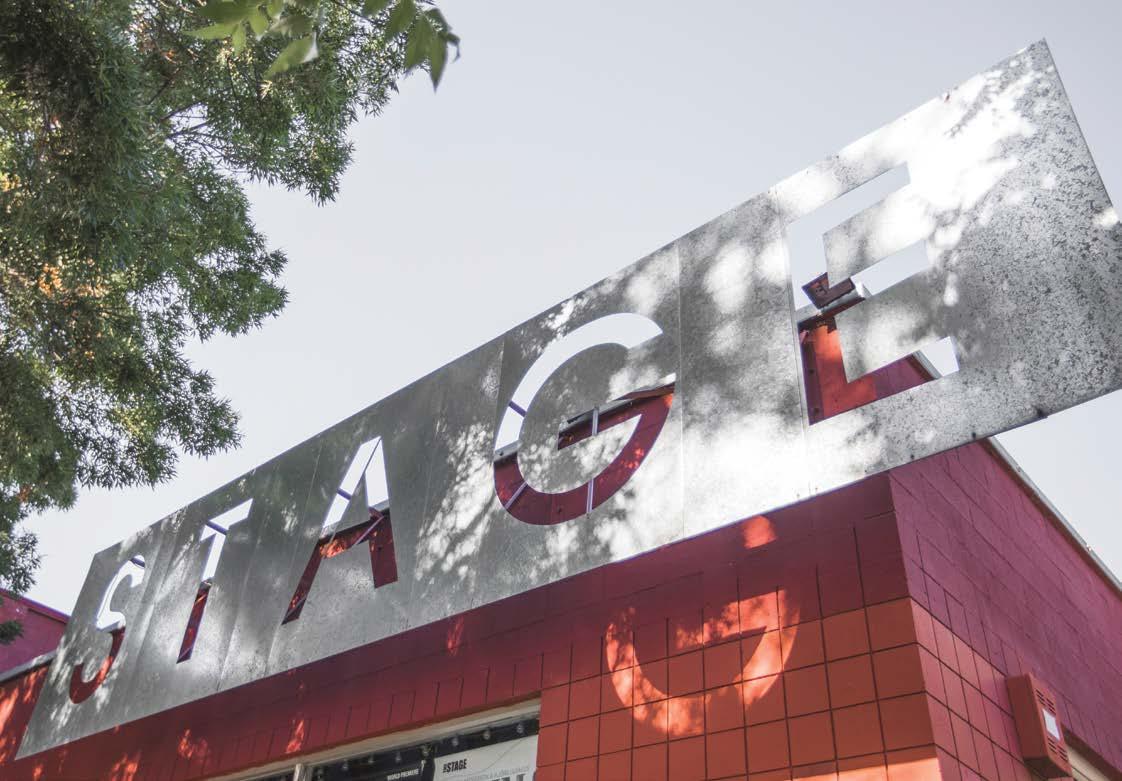


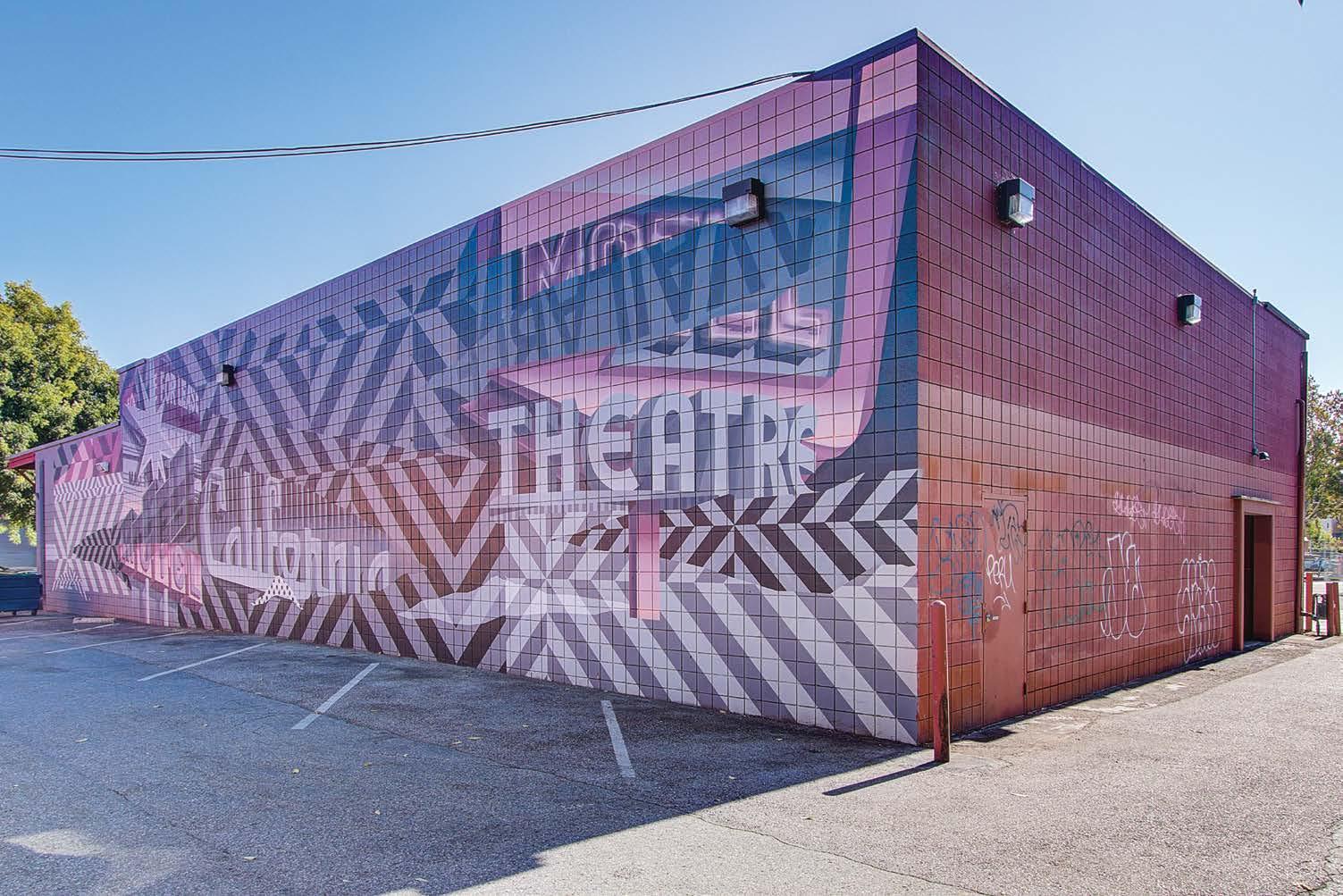
day. After three years, The Rep decided that they wanted to program that space. So the company had to move into a warehouse—now the ICA (Institute of Contemporary Art).
At this time, the city leadership started to take note of their work. So when King asked for support renovating that warehouse into a legitimate theater space, the City agreed, but earthquake retrofitting ultimately proved to be too costly.
“I believe that if you are an artist it is in your blood— in your DNA, and you don’t really have a choice.”
-Cathleen King
Fortunately, the owner of Eulipia called King and asked her to move back. She wisely dropped their fourth show and decided to do a new musical called Angry Housewives, which ran for almost three years. In the meantime, she was looking for another home in SoFA, which had since become the designated arts and entertainment district. The Redevelopment Agency helped them turn a Goodyear tire shop into a 188-seat off-Broadway theater which cost between $500 and $800 thousand. “We always like to say to the city that was the best investment they ever made in SoFA.”
But there are some challenges to working in a retrofitted existing building—the bays where cars pulled in for work still remain as part of the structure, for example. Increased production requirements have meant that the Stage has outgrown the space, so King is now looking to past partners like Barry Swenson to help rebuild and redesign the space in harmony with the SoFA community, home to their company for 37 years.
“Initially, as a collective of artists, we saw possibilities—we didn’t really see problems or challenges. There are days when there is no way we are going to make it through this crisis, but that is when the magic happens. You have to rise above that.”
Part of that magic comes from fulfilling a vision to employ artists in the space where they live. Each year, the Stage provides work for over 100 artists and 8 employees, which keeps their seasons a little bit edgy. It has always been part of their mission to produce new and emerging playwrights and engage new talent, including commissioning new work from celebrated playwrights like Luis Valdez at El Teatro Campesino.
“We were always rebels at heart, but we had a sense of commitment to our community. It is a collaborative process. Theater is about that. I love to collaborate, so this is a natural transition for me.” C

Much has been written and said about near-death experiences— tunnels of light, life flashing before one’s eyes, conversations with God, and the like. What happens in the netherworld between the living and dead continues to fascinate and frighten us. Graffiti artist Benny Diar has visited that mysterious place and returned to tell the tale.
It all started on a February night in 2008. Benny was driving with two friends in his 2005 Cadillac when he took a turn way too fast. He hit the median, snapping the SUV’s axel in half, sending himself barreling through the air into a tree. Amidst a hellscape of twisted metal and fire, Benny lay waiting for what would turn out to be the first in a series of miracles. “There just happened to be a police officer at the gas station across the street. My neck was broken, I stopped breathing, and would have died right then and there, but, luckily, the cop had a bystander using his fire extinguisher while [he was] reviving me,” Benny recounted. Once the fire truck arrived, Benny’s broken body was pried from the wreckage using the jaws of life. Luckily, his two friends escaped without life-threatening injuries, but Benny was rushed to Sutter Hospital in Roseville, where his troubles were just beginning.
“At the hospital, my heart stopped beating many times. On five separate occasions, they had to use the defibrillator to bring me back,” Benny shared. As fate would have it, Benny had just gotten a new tattoo two weeks prior to the accident—the phrase “Death Cheater” was written on his shin. To the amazement of his doctors, friends, and family, this tattoo would become a prophecy.
FIGHTING FOR SURVIVAL
As Benny’s loved ones gathered at the hospital, a series of life-threatening events occurred. He was heavily sedated because his body was in shock and fighting the life support machines. Along with his heart stopping almost every time he was moved, he developed deadly pneumonia, and at one point had a 108-degree fever. Benny has vivid memories of the dreams he had while comatose: “I thought I was a vegetable, and they were about to pull the plug. It felt so real and lasted for what felt like days.” Benny continued, “In these neardeath dreams, at one point, I was put in a drawer in the morgue. It felt like I was between life and death, and I have never been so scared.”
Despite being in a coma, Benny was aware of everything going on around him. In the waiting room, there was an intense discussion taking place between Benny’s friends and family about whether to place a DNR, or do-not-resuscitate order, on him. Essentially, a DNR is a legal order to withhold life support or CPR to a person should they stop breathing. This type of order is typically invoked in grave cases where the goal is to minimize a person’s suffering in their dying moments.
According to the doctors, Benny had little chance to live, and if he did emerge from his coma, they surmised his 108-degree fever would leave him with major brain damage. While his loved ones were in the midst of this agonizing decision-making process, the doctors decided to bring Benny out of his sedated coma. “I remember when I came out of the coma, they asked me if I wanted George Bush to make my medical decisions. They were kind of joking around and I was like, f--- that; that’s when they knew I was lucid enough to make my own decisions.”


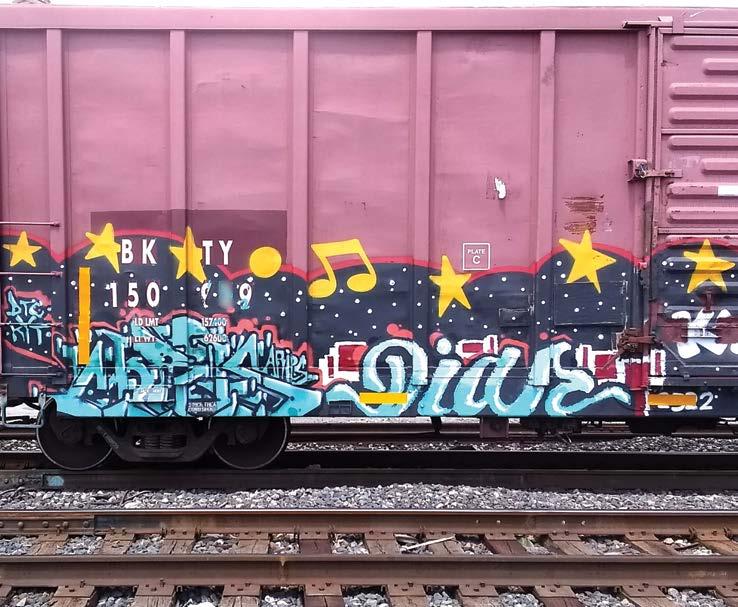


Six-year-old Yolanda Guerra sat at the dining room table with a Dick-and-Jane elementary-level reader. The strong, bold print matched her growing confidence as she strung words into sentences. Her father sat next to her and watched her read. “Mija, what is it about? Tell me.” She started saying the sentences out loud. “Which word is that on the page?” he asked. “What’s that word?” he pointed, “and that word?” She looked at him, and he said, “Mija, I don’t know how to read.”
At 18, for a graduation present, Yolanda received money from her father. She spent it all on buying novels. “When he asked what I got, he started crying. My father and I were connected intuitively. He created a space for both of us to learn.”
Gratitude for her father inspired one of Yolanda’s most well-toured pieces, “Love, Strength, Will and Power of Protest (Little Iron Vagina),” an installation work in which a small iron with a glowing, red center sits atop an ironing board. Flanking the brave little machine, two wooden panels with handwritten cursive describe
a memory from the early ’80s, when Yolanda was 13 and her older brother demanded she iron his shirt. When her refusal escalated into an argument, and her mother sided with her brother, her father stepped in and freed Yolanda from the outdated expectation that women must cater to men.
Much of Yolanda’s art explores the culture she inherited from previous generations. For example, one of her worksin-progress is an untitled textile sculpture about dismantling shame, for herself as much as her mom and dad. “My parents were hit in elementary school for speaking Spanish,” Yolanda explains. “I need to let go of the guilt my parents had.” As a child of assimilation, her English is fluent, but her Spanish is hesitant. “I have students who ask, ‘You’re Mexican–how come you don’t speak Spanish?’ We have to talk about the colonizer!”
A full-time artist with her own studio at the Alameda Artworks, Yolanda has been teaching art for eleven years. Born in San Jose as the youngest of nine, she chose to pursue her BFA in Art while her classmates became engineers or graphic il-
Written by Esther Young
The Alameda Artworks 1068 The Alameda San Jose, CA 95124 yolandaguerra.com
Facebook: YolandaguerraArt
Instagram: yolandaguerra23

“My father and I were connected intuitively. He created a space for both of us to learn.”
– Yolanda Guerra







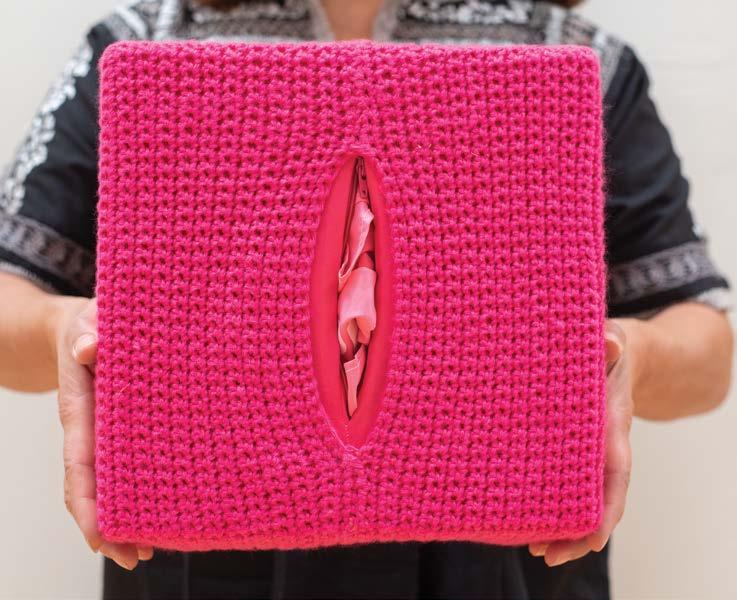
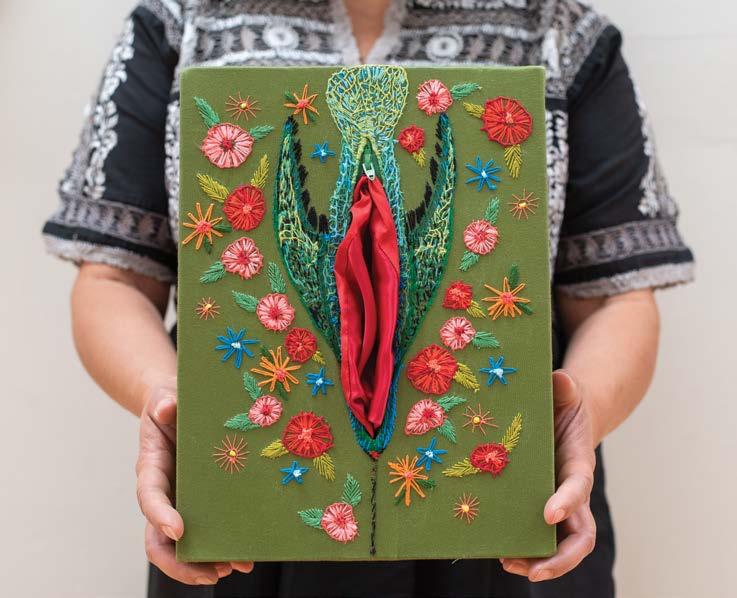
lustrators. She found an affinity for writing, which she sometimes embroiders into her artwork: her own words mix with those of Pablo Neruda and Sandra Cisneros in “She Gave Birth to Joy and Poetry,” a sculpture composed of a zip-up cloth tissue-box with smooth, dried flaps of colorful acrylic paint and butterflies. Its satin lining contains lines of poetry celebrating the beauty, depth, and functions of the vagina.
Many of her recent pieces are woodblock prints about families separated from their children. Yolanda sees these works as healing for herself and possibly for many others as well. “I want to show love and hope and pain, but pain in a way that people can see the beauty of family, of Mexican people,” she says. “I want to be some kind of voice for people who are not always heard.”
“I think that’s why I’m a teacher too,” Yolanda reflects. “Each time I walk into a classroom, I want to honor the teachers I had.” During her time at
Evergreen Valley College, which Yolanda attended for junior college before San Jose State, she found creative women professors who were “kind and open to people’s craziness.” The instructor whom she dubs her “first art mama” once told her, “You have to follow your own path. Because if not, what kind of life would that be?”
And so, Yolanda expresses her truth in every way she can. She reminds her city it was once a farming community; it can continue to innovate without exacerbating wage gaps. She sheds tears each summer as another class of students graduates; she makes art about them, wishing them well. And eventually, confirmations arrive at the door. Her students return to their art mama and tell her they still enjoy drawing or painting or printmaking. And Yolanda rests assured she’s at the right place in life. “Whatever pulls me in the direction of where I need to be, I follow that. Despite whatever situations are around. That’s just my way of living.” C

Making it in Santa Cruz by painting, tattooing, sewing, and dancing.
When it comes to street cred for a Santa Cruz artist, Amanda Payne may go unrivaled. Her parents met at the beach boardwalk, and after the ’89 quake knocked their house down, she grew up in a yurt on a nine-acre property in the Santa Cruz Mountains. When it came time to get her own bedroom at age 12, they converted an old redwood water tank into her sleeping quarters. With such an eccentric childhood, it’s no wonder that today she’s a multi-talented artist at the helm of a small, creative empire that spans printmaking, painting, tattooing, burlesque performance, and even her own line of handmade lingerie.
Amanda began her path towards the arts at a young age. After her father’s passing, she was raised with the help of her older brother, a UCSC graduate who studied illustration. “My brother didn’t really know what to do with kids, so he sat us down and taught us to draw,” she explained. Later on, she got involved with the 4H, where she learned to sew (her first job was on a sheep farm). She didn’t necessarily know it at the time, but the skills she was acquiring in her young life would become the foundation of a career in what she calls “never having a real job,” a goal she’s managed to succeed in for the last 11 years.
Growing up in a remote part of Santa Cruz County meant the energy of urban environments had a lot of appeal. “I got my driver’s license the minute I could,” Amanda says, and she reflected on skipping school for impromptu trips to San Francisco to experience more culture. In high school she started hanging out in tattoo shops and began learning the art of tattooing. “This was around the time Miami Ink became popular, and tattoos were starting to become popular with all walks of life.” Today, she still does tattoos and says her strengths are “pretty things.” Looking through her Instagram feed, you’ll see samples of her work in color-rich peacock feathers and even a scene from the 1976 horror film Carrie
Written by Brad Sanzenbacher
Photography by Daniel Garcia
velvethammertattoo.com
Instagram: _kupferdach_






There’s a vintage style to Amanda’s tattoos, and that carries over into her other mediums. As a painter, she brings to life ’60’s pinup girls with a body-positive sexiness that many female viewers see themselves in. “I love it when a woman sees one of my paintings in an art show and says, ‘that’s me.’ It could be the body, the face, or the attitude.” With her quirky humor, Amanda says she’s drawn to the aesthetic of pinup girls. “Everyone loves a pretty lady. Nine out of ten doctors recommend it.” She also does commissions, which she says are mostly “dogs and grandmas.”
If we’re talking about Amanda, pretty ladies, and sexiness, we need to talk about Never Nude, her made-to-order lingerie business. Never Nude (the name is a reference to the character Tobias Fünke of “Arrested Development,” who claimed to suffer from a deep phobia of being nude) was born out of her own desire to wear underwear she liked and frustration with not finding it in stores. The business is made possible by the sewing skills she learned way back in 4H and costume design skills from high school theater. With Never Nude, she’ll take your personal measurements and sew lingerie you’ll actually love to wear. It’s a mission that’s important to her personally. “Wearing nice underwear makes you feel good. It’s the foundation of your day.” She sells her lingerie on Etsy and at a few pop-ups around Santa Cruz.
If there’s a common thread to Amanda’s work, it’s an appreciation of the body as art. With her tattoos, she improves the aesthetic of the body with new colors and beautiful designs. In her painting and lingerie, she celebrates women’s curves and helps women reconnect with a sexiness they perhaps didn’t realize they were missing. In burlesque, she takes this to the next level by throwing her own body into the mix as “Baberaham Lincoln” (aka Honest Babe) in the monthly Sin Sisters Burlesque show at the Kuumbwa Jazz Center.
Sin Sisters is the longest running show of any kind in Santa Cruz,
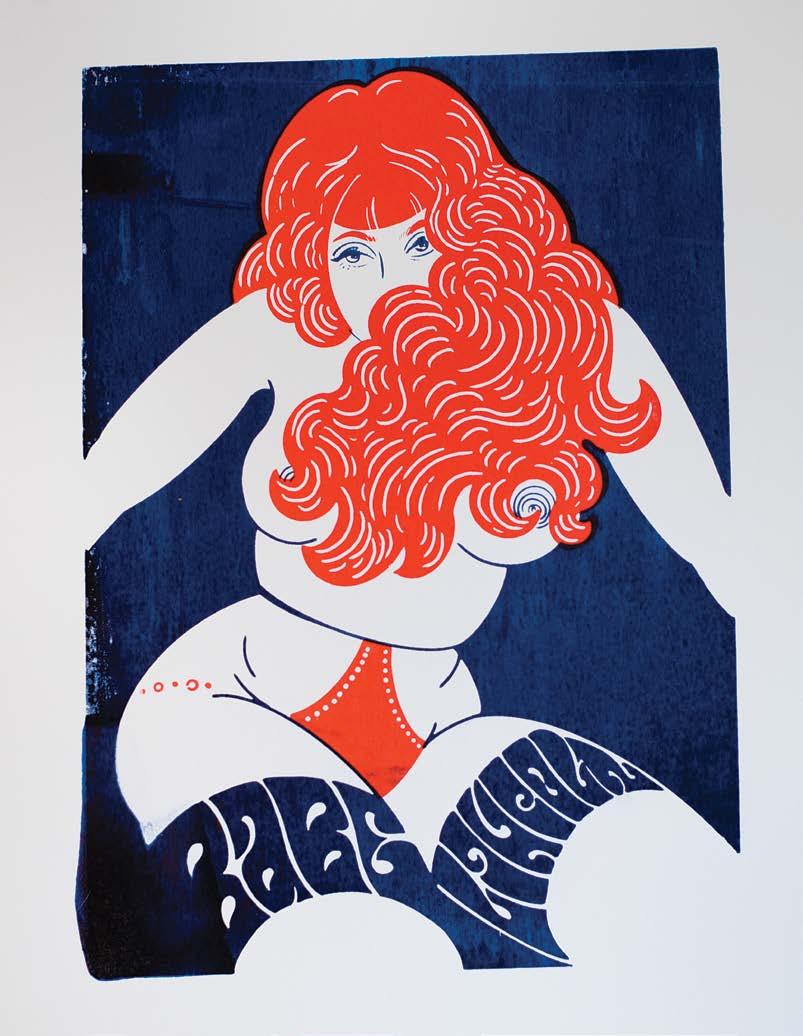



“Wearing nice underwear makes you feel good. It’s the foundation of your day.”

-Amanda Payne




and it gives Amanda an opportunity to combine her diverse skills. She designs her own costumes and writes, or semi-commandeers, dance bits for her act, and, of course, a burlesque show gives the audience a lot of opportunity to see her tattooing skills on the bodies of her fellow Sin Sisters.
Like many artists in Santa Cruz, Amanda is trying her best to handle the squeeze of a community in flux thanks to tech-driven rent increases and demographic shifts. She reflects on her first apartment, a three-bedroom unit that she cohabited with two roommates for a modest $1,500 per month. The same unit, she says, is now $3,600 per month. Rising rents have also claimed downtown institutions like Caffe Pergolesi and Logos Books and Records, which Amanda says has taken away reliable employers for people looking to earn some extra cash while trying to make a living in the arts.
To resist the squeeze, Amanda and 12 other printmakers have banded together to start Little Giant Collective, a fully stocked printmaking studio in a retail space on River Street. Printmaking requires a lot of space and specialized equipment, and by splitting the cost, Amanda says the process is more feasible and also opens up new opportunities to host events like printmaking and other art classes.
Amanda says “making it” as an artist doesn’t mean what it used to mean. Making a living in art isn’t just about being a great artist, but a great internet marketer as well, and while the internet can create new opportunities, it also presents new struggles. Despite the challenges, Amanda is one of Santa Cruz’s creative powerhouses, and given the diversity of her talents, she seems to have enough irons in the fire to survive in a rapidly changing economy. The vintage aesthetic of her art is a perfect vibe for the NorCal coast, and her tireless work ethic, driven by her passion for creativity, gives her high output in multiple mediums. Whether you need a tattoo, a painting, or some underwear that will make you feel good, Amanda is likely willing to put her talents to work for you. C





What kinds of people become full-time artists?
Sometimes it’s the kind that meticulously plotted their futures, enlisting in daily portfolio camps and yearly summer intensives. Other times, it’s the kind—like Kristina Micotti—who let their careers evolve naturally, flowing with the course of their lives, somehow winding up exactly where they wanted to be. In every way Micotti interacts with her creative practice—whether in choosing it, developing it, or taking it full-time— Micotti proves that you don’t always need to plan. Sometimes it just works out.
Micotti didn’t start college as an art major; she didn’t even take art classes in high school. She focused, instead, on swimming and water polo as a teenager and made drawings purely for fun, making her friends laugh with cartoons, birthday cards, and caricatures of teachers (hidden carefully in her backpack so they would never find out).
The most formative art training she received in her youth actually took place when she was a kindergartener, rollerblading to lessons at a neighborhood woman’s house. The classes were fun, but Micotti’s deepest impression of the experience came from the gallery shows at sessions’ end. “I remember feeling really special, really cool,” she said of the exhibits. “Because, when do you ever see your art in a frame when you’re six or seven?”
When it came time for Micotti to pick a college, she stumbled into San Francisco State as a communications major. It never felt right—dropping in and out of classes, struggling to find a good roommate— until she tagged along to a friend’s orientation in the School of Art. That room of painters, printmakers, and photographers was like a lightning clap for Micotti. She said of the moment, “I realized this is where I’d love to be—this is what I want to do. I feel like when you’re around other creatives, you speak the same language, and you instantly click in. You just instantly know when you meet someone else like that.”
Shortly after finding her calling, Micotti transferred to Point Loma in San Diego as a graphic design major. She took Drawing 1 with classmates who had a much more formal art education—but she was never intimidated by it. In fact, it became an advantage. “Since I didn’t have traditional training, my style was more developed than other students starting out,” said Micotti. “I kind of just found my own style from how I drew and developed from there. That’s what set me apart a little bit from traditional fine art.”
Attending Point Loma soon revealed a huge perk—a study-abroad program called Euroterm that toured England, France, Germany, and Italy. Micotti and her friends took figure drawing courses in Paris and art history lessons in Florence—studying Michelangelo’s sculptures and Giotto’s bell tower during lecture and then tracking down these masterpieces after class to admire them in person. From the trip, Micotti received a deeper appreciation of creative craft, a clearer vision of her own aesthetic, and memories she’ll treasure forever. She said, “Basically, all we did was hang out, look at art all day, then draw in sketchbooks at pubs and coffee shops. A hipster dream!”
Upon returning stateside, Micotti threw herself into her studio courses, streamlined her style with cleaner shapes and lines, and found a reputation within her program as an artist to watch. She put in endless late nights on two illustrated series—one on the birds of the Tijuana estuary and another on folk heroes such as Paul Bunyan and Calamity Jane. She prepared not just for graduation, but also for a portfolio review by the American Institute of Graphic Arts—a prestigious event somewhat like a science fair, in which judges browse work, provide feedback, and give awards. “[I was] so nervous, so sweaty,” said Micotti. “It was very competitive. But I’m still proud of the work I did.” And she should be—because her efforts nabbed the prize for best illustration and kick-started the rest of her career.

“I feel like when you’re around other creatives, you speak the same language, and you instantly click in. You just instantly know when you meet someone else like that.”
-Kristina Micotti




GOING FULL-TIME
Since winning the portfolio review in 2012, Micotti’s creative path has become paved with offers—on each of which she focused single-mindedly to turn every opportunity into a triumph.
The hype from that best illustration award led to her first solo show at Subtext Gallery in San Diego’s Little Italy, where she exhibited a dozen paintings and pen drawings featuring her favorite jazz singers. She worked around the clock to produce these pieces, dedicating all her time and energy to pump out top quality work. It paid off, of course, with a smash hit opening—multiple pieces sold and even more buzz generated about her talent. Somehow, Micotti did not expect such positive reception. “It was crazy; it was pretty surreal,” she said. “I’m just not used to that attention. That attention kind of freaks me out a little bit.”
In 2013, Micotti moved back to the Bay Area and started participating in San Francisco’s Renegade Craft Fair—a curated marketplace where hundreds of artists vend their work to thousands (upon thousands) of guests. She stocked her booth with prints of her birds and folk heroes from college but found that her meticulous renderings of Paul Bunyan and Calamity Jane wouldn’t move off the shelves. She also happened to display some quick paintings of dogs—spur-of-the-moment pieces, just to fill out her table a little bit. And these sketches sold out almost immediately. This changed everything for Micotti. She said, “I could draw something for 10 seconds rather than spending hours and hours. I was able to paint spontaneously, what-
ever I wanted. I loved the freedom of it.” Micotti was hooked. She signed on to this new style at once and still uses it today.
Micotti’s success at art shows and craft markets only spawned more good luck for her career. She attracted clients such as FiveThirtyEight, Schoolhouse Electric, Triathlete Magazine, and the Optical Society, creating anything from lapel pins of scientists to thumbnail portraits of political bloggers. She landed wholesale deals with independent stores throughout California, such as Rare Device, Kira Kids Stores, Park Life, New Works, and Bay Made. And she held two more solo shows in May of 2019—more ink paintings of dogs in the Long Weekend, Oakland, and acrylic paintings of tigers and cheetahs in the Little Lodge, San Francisco. She even has a book coming out soon for which she did the illustrations: The Boob Book, published by Chronicle.
In the future, Micotti hopes to collaborate with bigger clients, make more home goods, and design large-scale murals for local tech companies. But really, she’s not that stressed about it. As she said herself, “I never really knew what I wanted to do with my art. I’m kind of just letting that baby grow on its own. Illustration fell in my lap because I just like doing it and that evolved into products. And then it’s still evolving, but different types of products. I’m going from a $10 pin to a $170 blanket. The products are changing and the prices are changing. I’m just letting it grow organically, just seeing where it takes me.” C

“We’re at the epicenter of where change is happening in the industry, so it’s important that we’re elevating the perception of what’s possible with this plant.”
–Randy Suarez
It’s golden hour in downtown San Jose, and sound waves of tuba and saxophone are rolling through a tree-lined Post Street. Don Pedro’s Authentic Mexican Food’s neon sign glows over tables of Modelos and the outdoor dance floor of one of California’s biggest jazz festivals. Across the street Divine Wine is pouring a new lineup of tastings. Next door, across the threshold of an intimate, invite-only 50-name guest list and an incognito crowned bear emblem, Pageboy Salon has opened its doors onto a spread of charcuterie boards, sparkling water, and a curated cannabis flower bar featuring Sherbinskis pre-rolls and vape pens alongside a selection of Plus Products mints and gummies. The mirror-lined salon bar is dotted with bowls of THC-infused raw honey by Potli, plates of brie and salami, and a shared silver platter of several Sherbinskis joints balanced on the lip of gold ashtrays.
House Caviar is the host of tonight’s invite-only, 21-plus event. What essentially became box office seats to San Jose Jazz Summerfest, this social cannabis event is one of the
first of its kind for San Jose as House Caviar forges the path toward public experiences where cannabis is the cocktail of choice.
House Caviar, founded in January 2019, offers a full cannabis experience through private events. Specializing in curating exotic flower strains (the part of the marijuana plant that blooms and becomes products like joints or oil for vaporizer pens) that are otherwise inaccessible to San Jose’s consumers, the company seeks to help people discover and embrace how cannabis can enhance their lives in meaningful ways. If San Jose’s homegrown and nationally-known Caliva leads the US in growing and selling consistent, mass-produced strains, House Caviar sets the bar high for curating and serving rare, high-quality flower. The House Caviar logo embodies this commitment to quality—a crowned California black bear curating his head stash of fine (canna)caviars. This quality and expertise comes with the confidence to facilitate an expertly-regulated, truly positive experience for first-time consumers and fellow
connoisseurs (or more cheekily, cannaisseurs, as they’re officially becoming known) alike.
A few weeks prior, sitting at a sun-soaked table in San Pedro Square Market with a Friday night band starting sound check, Antoinette arrives with olive eyes and an iced Tokyo from Voyager. She is poised, warm, and disarming—and articulate. “The cleanliness of exotic flower is hidden [from consumers] right now because of the stigma; the type of high from this kind of flower offers consumers ease when it comes to socializing, with none of the negative after-effects that come with alcohol. If everyone walked away [from our events] feeling welcome and comfortable around cannabis, whether they consume or not, I’ve done my job.”
Antoinette Vu is CEO and one of four cofounders of House Caviar, alongside Brian Vu, her husband of seven years, and Johanna Suarez and Randy Suarez, her sister and brother-in-law. Together, they believe they can do and be more as a brand. Randy said it best, “We’re at the epicenter of where change is happening in



Two local Epicureans are creating dishes in the San Jose spirit.
When you’ve dedicated your life to a craft, it’s difficult to put its beauty into words. Explaining what makes something work becomes less about its construction and more about an artistic or philosophical approach to what really makes something work. In this sense, food is no different from any other art form—if you ask inspired chefs what makes their food so special, chances are, they can’t give you a simple breakdown. They’ll wax poetic about inspiration and what guides them to deliver something truly fantastic to people’s plates. Josh Hanoka and Anthony Jimenez are two such chefs.
Brought together by history and mutual respect, Hanoka and Jimenez launched Braise in 2017 to bring a new kind of restaurant to San Jose. The two of them started their own cooking endeavor after years of building their talents cooperatively and individually. Braise is built upon their shared desire to create a community by serving new dishes with fresh, local ingredients.
Written by Yale Wyatt
Photography by Daniel Garcia
Braise Restaurant and Bar
1185 Lincoln Avenue
San Jose, CA 95125
braisewillowglen.com
braisewillowglen
Facebook:
braisewillowglen
Despite knowing each other since high school, Braise is Hanoka and Jimenez’s first collaborative project. They studied together under Emile Mooser in their beginning years but separated as Hanoka cooked across the nation, returning to San Jose periodically. Meanwhile, Jimenez was working in the top restaurants in San Jose, honing his craft and developing his own identity as a cook. At the time, the two of them held no plans to start their own restaurant, instead focusing on learning as much as they could at whatever opportunity they took. “When you’re younger and a cook, you need to learn from other people,” says Hanoka. “You want that knowledge before you take the leap on your own.”
The next time Hanoka returned to San Jose, they took that leap. He started Bray Butcher Block in San Pedro Square and became a co-owner of Cinebar. Jimenez was working at the Table in Willow Glen. The two reconnected once again and realized that they had been working for others up until this point in their career, and now



they wanted to do something big for themselves. Soon afterward, the idea for Braise was born. “I came back to [Jimenez], seeing all the great things he had done at the places he was at,” says Hanoka. “With Braise, the opportunity finally arose, so we said ‘let’s do this.’ ”
“There’s an amount of finesse and respect you need to have in the kitchen. You need to keep that at the forefront of your mind— dishes will come together around that thought process.”
–Chef Anthony Jimenez
Of course, opening a restaurant in the Silicon Valley is not an easy task. Hanoka could only describe it charitably as “bureaucratic.” When they set out to make Braise a reality, Hanoka and Jimenez set benchmarks for when they would secure a property and open their doors, but as with all great plans, those goals were missed due to several delays. Each moving part in opening a restaurant requires a form signed and departments to communicate to, on top of securing the necessary capital.
“There are many hoops you have to jump through,” says Hanoka. “And even when you jump through them all, things can still fall apart. It’s very rewarding when you get to the fruition of it and open your doors. But that’s when the new set of problems come in.”
Hanoka says that the hardest part of owning a restaurant is opening one, considering that 92 percent of restaurants fail within their first year. It’s a grim statistic, but Braise had a pretty strong start when it opened in 2017. Yet nine months after the restaurant opened, there was a freak electrical fire in the back of the building, and Braise had to be closed for nearly three months. All the momentum Hanoka and Jimenez had built screeched to a halt, and they had to start from scratch once again. Yet the fact that Braise has survived two separate openings bodes well for the restaurant’s lasting power. “Honestly, we still haven’t fully recovered from the momentum we lost,” says Hanoka. “We had a hard run at it, but all struggle and strife builds character. I think we’ve been able to come together and communicate much better because of it.”
Hanoka and Jimenez refuse to categorize the food they offer at Braise, instead adopting an ever-evolving perspective on what the restaurant can be. By prioritizing a lack of concrete focus on the menu, they can bring variety to their clientele and defy their expectations. Since everything in the restaurant is made from scratch, Jimenez constantly scours the nearby farmers’ markets to find the freshest ingredients. “Most people just grab the first vegetables they

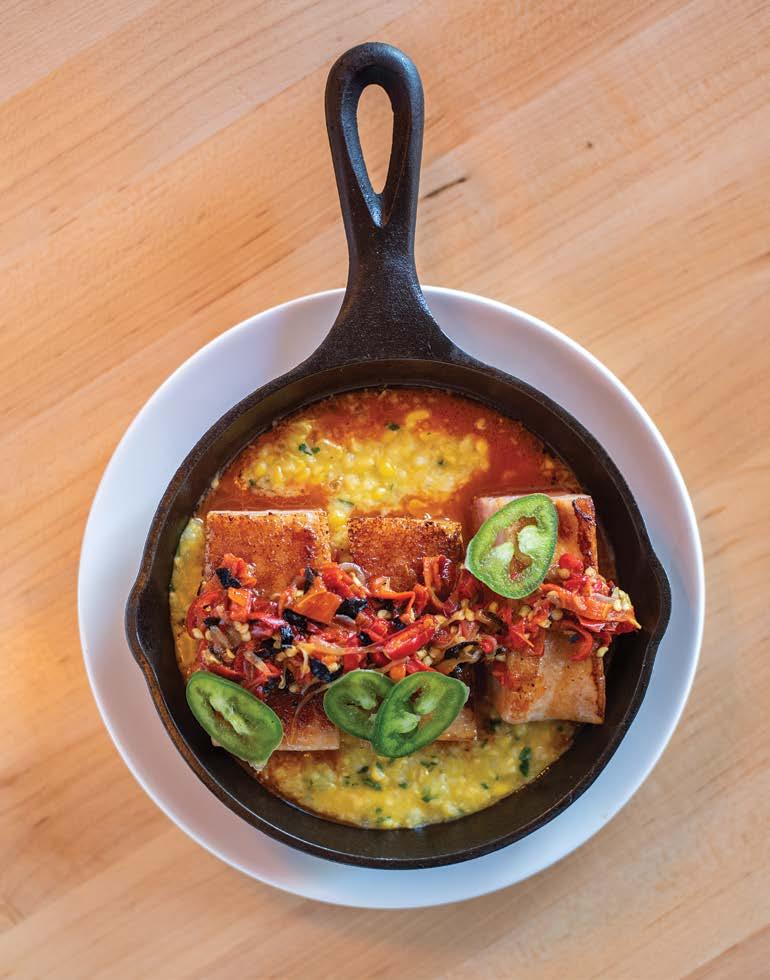




see,” says Jimenez. “That’s fine. Leaves all the fresh stuff for me.” If he finds something particularly inspiring, he might make a new dish that could be this week’s special or be included in the menu. Jimenez believes you can only make great food out of better ingredients.
Still, even with this desire to never settle into a routine, Braise doesn’t want to make something unrecognizable to the public. Hanoka identifies with a more classic form of American cuisine, whereas Jimenez works in the new school, but the two don’t want to limit themselves to these arbitrary parameters. The ordinary customer doesn’t think of food in terms of cooking schools, so Hanoka and Jimenez incorporate the best approach of each into their dishes—whatever will best resonate with their clientele. As a result, their menu includes delicacies like lamb tongue pastrami, broccoli di ciccio, and their famous bone marrow PB&J.
Of course, this leads to an interesting process where the two determine what will stay on the menu and what will get the chop. Hanoka typically works the front of the store, so he pays attention to how people interact with their meals. Jimenez has a more intuitive approach—he checks what plates are left unfinished and what gets sent back to the kitchen. If the two start detecting a pattern, they’ll decide if an item on the menu needs an adjustment or to be replaced entirely. With most recipes, they alter one particular ingredient or change its base altogether, giving themselves the opportunity to turn one dish into something else entirely. “There’s an amount of finesse and respect you need to have in the kitchen,” says Jimenez. “You need to keep that at the forefront of your mind—dishes will come together around that thought process.”
(Opossite page) 1. Shaved green papaya salad, napa cabbage, sliced ginger, jalapeno,cilantro, dressed in a citrus-garlic vinaigrette & topped with toasted coconut,crunchy split peas, and crushed peanuts. 2. Tomato braised pork belly served with Brentwood yellow corn porridge & a charred jimmy nardelli pepper jam 3. White cheddar beignets topped with orange blossom honey & nutritional yeast 4. Shaved shinko pear, cracked black pepper, sea salt, honey & seascape from central coast creamery 5. Best of Both Worlds, vodka, Fassionola, Lemon, Saline, Sparkling Wine
One thing in the cooking business is clear—you must always think of the future. Hanoka and Jimenez are looking forward to holding special tasting events on Mondays when Braise is typically closed. Beer tasting and specialty dishes involving their local suppliers will be offered to people living in the Willow Glen area. On top of that, Hanoka and Jimenez believe the upcoming creation of the Google campus less than two miles away will be great for business and eagerly await serving new hungry stomachs.
All things considered, the two think they’ve hit their stride as Braise nears its two-year anniversary. Even with the few setbacks they’ve encountered so far, Braise has already accomplished many of the goals Hanoka and Jimenez set for it when they reconnected and sought to start their own restaurant. But don’t be mistaken—that doesn’t mean they are slowing down just yet. Braise will continue to evolve, and no doubt there will be something new and delicious next time you swing by. C

Written by Michelle Runde Photography by Avni Levy
Two sisters, one bakery, all the delicious.
or anyone who’s paused in the middle of a sidewalk to stare at a display of beautiful tarts or had their mouth water when catching the scent of a hot crust and savory filling, there are two sisters creating pastries in the Bay Area you need to meet. Co-owners and siblings LikLing and LikBin Khoo are taking on classic pastry cooking with sweet and savory options with their bakery, 43 & Company, occasionally putting their own spin on traditional flavors. On the savory side, they offer fan favorites such as chicken pot pie and bacon quiche, as well as a unique crispy, spiral curry puff with countless individual layers forming a swirl of golden-brown waves. On the sweet side, they have seemingly endless options from matcha cupcakes to mixed fruit tarts, apple turnovers, a hazelnut-espresso cake, various cream pies, and many other tantalizing offerings.
Each sister brings their own set of skills to 43 & Company: LikLing is the pastry chef, while LikBin works on the marketing and business side, although she does pitch in to assist with the baking as well. While they have different focuses, they share childhood experiences from growing up together. “Our biggest influence is our mom,” said LikLing. “That’s actually how we came up with the business name.”
LikBin explained the origin story: “It’s the number from our home address, from our childhood in Malaysia; that’s where LikLing especially, but also both of us, saw how our mom did the cooking and baking. We participated by helping her out. She loved to host family gatherings and parties, and she even used to conduct cooking classes in our home kitchen. Forty people would show up to learn how to cook, and we were the
little helpers.” Both sisters laughed, recalling the chaos of those events. “That’s where we’ve gotten our influence, so much of our family life centered around food,” continued LikBin. “Eating it, cooking it, baking it, enjoying it, sharing it; so we want to pay tribute to that memory and that experience.”
While LikLing and LikBin are working together now, they started out on very different tracks. LikBin, the older sibling, explained how she started in her professional life: “It’s amazing, we grew up in the same household, and [LikLing] decided that she wanted to go into cooking at a young age. I went a different route; I went into engineering.” For the last 17 years, LikBin has been doing engineering work, but has always wanted to have a business. “We’ve always been business-minded, which is an influence from our parents. They always had their own business, and we always had the impression that it’s better to own your own business, even a small one,” shared LikBin.
Meanwhile, LikLing seemed destined to be a chef from the start. She recalled her first attempt to cook by herself: “I was trying to be like [my mom], and I almost burned down the house when I was seven, trying to make french fries. I overheated the oil, it turned into a flame, and I dumped some water on it. So it turned into a big flare, and it burned some of my hair and eyebrows.”
“There was a black spot on the ceiling!” added LikBin, laughing as she, too, recalled the catastrophe. Despite the scorching start, LikLing went on to train at the California Culinary Academy and later interned and worked full-time at Tartine Bakery in San Francisco. This led to 10 years of working on the East Coast at different resorts,




“Our biggest influence is our mom. That’s actually how we came up with the business name.”
“I think our basic philosophy with the food we offer is ‘sharing with you the food we love.’ ”
–LikBin Khoo

restaurants, and bakeries, including owning her own bakery, Baker’s Dream, in New York state.
While they had often talked about opening a business together, it was in 2016 that they first started 43 & Company. “We finally decided the time was right and we felt ready,” LikLing explained. They started the company in 2016, with pop-ups on a part-time basis. “In fact, our very first pop-up was at SJ Made at the Whole Foods on the Alameda in San Jose. We still have customers who found us there and are still supporting us.”
While they made many valuable connections through their pop-ups, it was only the first step to getting a feel for the market and what people were interested in. “We really liked the direct interaction with the customer; so we thought, ‘How can we make this more consistent and permanent?’ ” LikBin said. “So the natural thing to do was to go to the farmers’ market, because that happens every week, and you’re guaranteed to have lots of visitors and regulars. With a pop-up, people have to chase after you, and most people won’t do that.”
Today, you can find the booth for 43 & Company in three farmers’ markets along the Peninsula. On Saturdays, they are in both the Sunnyvale and Saratoga markets, and on Sundays they’re located in Palo Alto. Although they’re only selling at their booth on the weekends, 43 & Company has already built a pastry-lover following. “We’re slowly gaining more and more customers, and it’s very reassuring to see people coming back to us and getting to know our customers who return every week,” said LikBin. With her business background, LikBin also knows the importance of convenience to customers and has created options for people who aren’t able to visit one of the farmers’
markets on the weekend by offering online orders and free delivery within 20 miles of Santa Clara, allowing them to serve customers from San Jose all the way to Redwood City. “It’s quite a bit of traffic and traveling, but right now, since we don’t have a storefront, we thought that’s a service we want to provide so that we can keep serving our customers on weekdays,” said LikBin.
In addition to online ordering, they also offer private catering and have recently started baking for weddings, and they’re excited to expand into other events. With LikLing’s experience handcrafting everything from mini tarts to pies, cupcakes, and more, their beautiful and delicious baked goods are a perfect treat for any event. “My background is generally in sweets, and that’s what I love to do. But we also like to introduce Malaysian specialties. The curry puff is a very traditional Malaysian dish. We thought we’d offer something that’s a little different,” says LikLing.
“The chicken pot pie, the mushroom leek, it’s traditional American comfort food. The curry puff is a comfort food for us, so I figured we’d combine with our pastries.”
LikBin expanded on their flavor inspiration:
“I think our basic philosophy with the food we offer is ‘sharing with you the food we love.’ So it could be anything, because our background is Asian, but also American because we’ve lived here for almost 20 years.” There’s a wide variety of food that they both really enjoy, and that’s how they decide what they want to offer. “It’s not any particular group of food; it’s sharing the food we love,” said LikBin. So next time you’re craving a fresh, handmade pastry that’s bursting with flavor, look no further than 43 & Company for your next indulgence. C
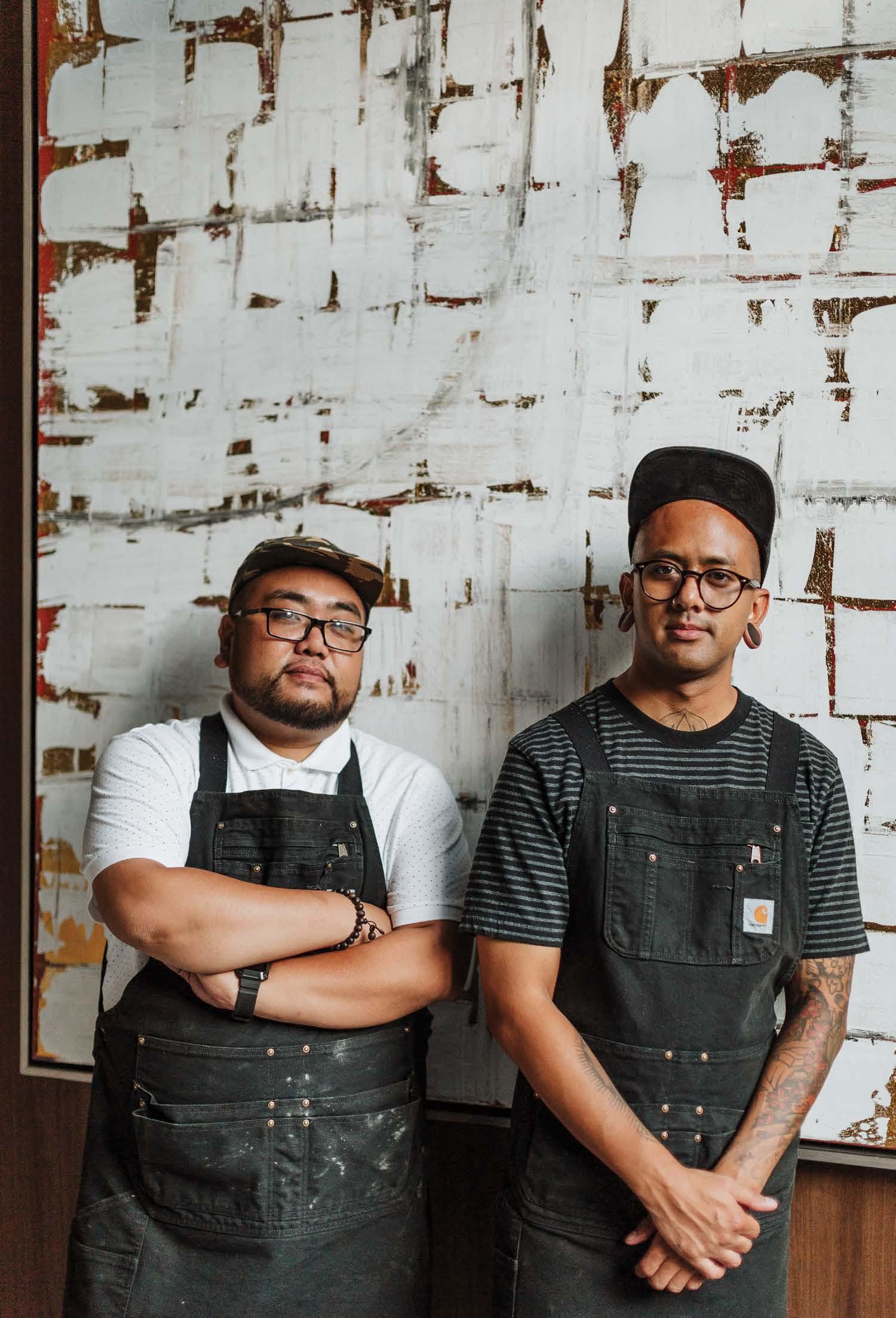
Written by Grace Talice Lee
“Barya” is a Tagalog term that translates directly into “loose change”—because, as chef-owner Rod Reyes says, “Filipino food should be affordable, even in a fine-dining kind of way.”
But there’s also a lesser-known definition of the word: “barya” can also mean “a change in environment or situation.” And this kind of change is what really interests Reyes, who is always learning and evolving, whether in his relationship with food, or his shift in careers, or his aspirations to elevate the food scene, both locally and beyond.
COOKING: FROM PUNISHMENT TO PASSION
Reyes first started making food as his mother’s preferred form of discipline—sentenced to peeling lumpia wrappers as a restless child, relegated to the most mundane of tasks because he wasn’t yet old enough to handle a knife. As he got older and nimbler, he started taking control in the kitchen— and taking risks. Sometimes he braised a short rib just right. Other times he sank ninety dollars into a mac ‘n’ cheese that no one could choke down. “It was terrible because of the cheese I selected,” laughs Reyes. “There was a tanginess to it that just killed the dish.”
But Reyes wasn’t ready to pick just one passion. Upon entering college, he majored first in graphic design, then photography, then pre-pharmacy. Then he left school in favor of making rent and car payments with a series of administrative jobs at dental offices and hospitals—while also moonlighting as a DJ, spinning vinyl into the early morning and then sneaking off from work to power nap in his car. But it was actually because of his music that he discovered a deeper interest in food.
After a long night of partying, Reyes would bring all his friends home—and feed them. “I always
It’s all in the name.
looked forward to cooking for people. That’s when I finally realized it’s something I enjoy doing—seeing other people enjoy what I created.” He believes it’s all connected: the graphic design, the music, the cooking. He says, “There was always something about creating something and seeing people react to it that fed my soul. I loved it. I loved the reaction from it. I love making things for people.”
Reyes found a spark in cooking that was stoked into a small flame by his then-girlfriend, who showed resentment when he stayed out late for DJ gigs but glowed with encouragement for his culinary talent. Every time they went out to eat, she sampled their dinner and declared, “I think you could make this. Actually, you could make this better.”
So he went home and tried it—tweaked it, studied it. Unable to attend culinary school without financial aid, he found an education in shows like Yan Can Cook and Essential Pépin, watching and replicating how the master chefs chopped their vegetables. With this steady practice, Reyes’s cooking soon overtook his turn-tabling. Now his recipe for mac ‘n’ cheese—with Gouda, sharp white cheddar, cream cheese, and cottage cheese—wins the crowd every time.
CHEFING: FROM SOMETIMES TO FULL-TIME
As Reyes’s passion grew, so did his ambition. After years of casually throwing dishes together after drunken nights out, he finally put his first menus together for a couple taste-testing parties. A dozen friends crammed into a tiny apartment for some of his crispy octopus leg over white bean salad—or his braised albondigas over elote-style polenta—or his red beans and rice with smoked turkey leg and andouille sausage topped with fried chicken thighs.


Reyes cooked from all over the map, with influences from New Orleans to Mexico. He came home to Filipino cuisine, though, shortly after his mother succumbed to lymphoma during the summer of 2017—when he somehow managed to recreate her legendary and seemingly inimitable recipe for chicken adobo. “It brought me to tears because it tasted like the way she would make it,” says Reyes. “It’s rare for that to happen, because she never measured anything. Every time I asked for a recipe, it was just a scoop of this and a scoop of that. Every time I made it, it never tasted like hers. And then this one time after she passed, I made it, and I nailed it. So yeah, I kind of teared up as I ate it.”
Reyes started throwing pop-up events with his take on Filipino food, commandeering kitchens in bars and restaurants whenever he found the chance. And about a year after recreating his mom’s chicken adobo, he quit his day job. Administrative work just couldn’t compare anymore. “I


was like, maybe this is time for me to focus on what I actually really love to do,” says Reyes. “When I was doing pop-ups, no matter how much work I did, it didn’t feel like work. I would pull all-nighters, and I just loved it. I wasn’t tired. It just didn’t feel like work because I was seeing the outcome of what I made and how people enjoyed it, versus sitting at a desk.”
Two weeks after going full-time on food, Reyes debuted Barya Kitchen at Undiscovered SF, a Filipino street festival in San Francisco. He sold out in two hours and attracted one of the longest lines at the event—even after running out of key ingredients, his patrons eagerly buying his rice bowls without the rice.
Since then, Reyes has hosted pop-ups at Camino Brewing Company, selling out in two hours, and Culinary Confidential, selling out both seatings, and returned to his second season of Undiscovered SF—selling out after four hours this time, even
“There was always something about creating something and seeing people react to it that fed my soul.”
–Rod Reyes


with twice as much food prep. By the time this story goes to print, Reyes will have recently served a pop-up dinner at Academic Coffee—a six-course, invitation-only event. And judging by his record, everyone who went will have loved every mouthful—and everyone who didn’t will be sorry they missed out.
CHANGEMAKING: FROM HERE TO EVERYWHERE
These days, Reyes keeps one eye on his balanced flavors and impeccable plating—and he keeps his other eye gazing into the future, which looks bright for all who live and eat in the South Bay. In the short-term, Reyes hopes to stimulate the pop-up scene in San Jose. He’s on the hunt for spaces that can seat 30 people at a time for dinner, perhaps at a low cost or for a couple seats at the table or of course for free, to support his mission to elevate Filipino food at an accessible price. Reyes says, “I would like to see venues being more open to these
types of pop-ups, to be more welcoming, to work with chefs who are trying to get their names out there and trying to build this dining scene that we lack in San Jose.”
In the longer term, Reyes keeps two goals in mind: first, to open a brick-and-mortar restaurant on South First Street and, second, to alter the broader perception of Filipino food. He wants to make the word “pulutan” just as common as its Spanish equivalent, “tapas.” He wants people to crave sisig and kare-kare just as often as they crave carnitas, tacos, or chicken tikka masala. Because, when the public becomes more accepting of another culture’s cuisine, they also become more accepting of the culture itself. And there’s no chef better to spearhead this movement than Rod Reyes of Barya Kitchen, where change is literally the name of the game. C
There’s a reason so many of us have such positive associations with coffee. Sure, it tastes great— but it’s not as if that flavor surpasses everything else you’ve ever passed over your taste buds. So what then? “It’s not so much about the coffee,” Bryan Chiem reveals. “It’s about coffee being the glue that brings people together.” He elaborates: “We can sit in a lab all day and talk about how it tastes or the science behind the coffee, but if we have no one to share it with then it means nothing.”
Chiem, founder of Tōno Coffee Project, acts as a sort of coffee ambassador. He’s one of the baristas who understand their impact reaches beyond the counter. “The farmers put in their work, they ship that over to the roaster; the roasters put in their time, then they hand it off to the baristas—and the baris-
tas hand it off to the consumers. Anywhere along the process, things can go terribly wrong,” Chiem explains. “The barista’s very much the front line of that. If I’m not making something as good as I think it can be, then, not only am I not doing a good job, but I’m doing a disservice to everyone before me.”
But beyond his commitment to represent the coffee he serves well, Chiem also brings specialty coffee to unreached demographics by opening his pop-up in all sorts of unexpected locations: warehouses and weddings, barbershops and thrift stores, even the Rose Garden. “I like spaces that facilitate more conversation and curiosity,” he explains. For instance, “I think people who thrift are from all walks of life, and they have a little more time to hangout and talk story and ask about what I’m doing.”
For him, this industry is so much more than profit. “I try my best not to be a coffee schlepper,” he states. “My goal is always to contribute to a concept so people feel welcomed to hang out and talk to their neighbors or people around them. That’s how coffee transforms a space.”
One of his favorite pop-up experiences was selling Vietnamese coffee out of a 10 by 10 space in the parking lot of Eastridge Center during the Vietnamese Lunar New Year Festival. He considered it an honor not only to source and support this emmerging region, but to serve a demographic with a pride and connection to that particular country. “The East Side community doesn’t see much of the type of coffee services that I put on,” he adds.
East Side, the neighborhood of Chiem’s childhood, is
Written by Johanna Hickle






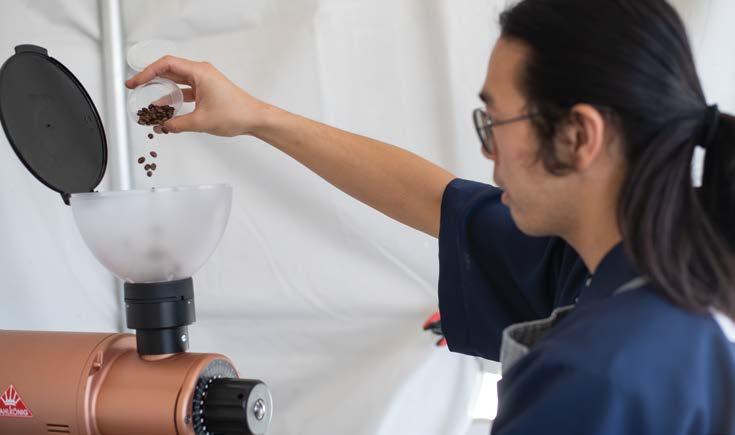



“Coffee is common ground for a lot of people. I use it as a connector or bridge.”
where his lifelong passion first sprouted. “I consumed coffee since an early age. There’s a VHS with my dad feeding me coffee in the crib,” the barista chuckles. As a young adult, he considered owning a coffee shop—a retirement dream. “But I went through this period of life where I was tired of waiting for things, and I was just doing things—and coffee was one of the things I was doing,” he describes. And weary of the digital flatness of doing design work, Chiem determined a more tangible pursuit was in order.
After uncapping a dry-erase marker and brainstorming names, floor to ceiling on the glass sliding door of his home, he finally settled on “Tono,” a title taken from the word “tone.” The name acknowledges
Chiem’s Vietnamese heritage and the tonal quality of Vietnam’s national language. Additionally, “When you’re drinking certain coffees you can pick out different tones or notes in the coffee,” he remarks. “Coffee as a beverage can also be a wholesome experience or it can be an exciting one or it can be a funky or funny one.”
Chiem also organizes events to introduce chain goers to specialty coffee and coffee lovers to each other. A string of successful latte competitions culminated in the Coffee Palooza this August.
“There’s a lot of South Bay shops doing great things, but I don’t think we get as much coverage or hype as the cool hip shops in San Francisco or Oakland,” he notes. This event included the South Bay Regional AeroPress
Championship, Waste-less Latte Art Throwdown, tastings, workshops, and a screening for a film about the odd yet iconic AeroPress coffee maker. Steve Cuevas of Black Oak Coffee spoke on roasting. Umeko Motoyoshi of Sudden Coffee revealed not only how to identify coffee notes, but how to discern which descriptions are subjective and which objective.
Like an ambassador, Chiem’s most basic function is to reinforce unity and forge connections. “Coffee is common ground for a lot of people,” he says. “I use it as a connector or bridge.” And, showing no signs of slowing, he will continue finding nonconventional ways to bring specialty coffee to the people. C

“I wanted to do something that was not bits and bytes but nuts and bolts.”
Written by Nathan Zanon
Making a world-class San Jose single malt whiskey
Spend an hour talking about whiskey with Virag Saksena, and it will feel like you’ve taken a master class on the subject. A longtime fan of the versatile spirit, Saksena is the cofounder—along with Vishal Gauri —of the 10th Street Distillery, one of San Jose’s first hard alcohol producers since prohibition.
Originally an engineer who dabbled in home brewing, Saksena’s passion for whiskey truly began when he tasted a limited edition Laphroaig that had been aged in sherry casks. It became his drink of choice, but when supplies of it ran out, he realized there truly was no getting it back. “It feels like a sense of loss—something you really enjoy and you cannot find it anymore. You grow to love a certain expression and then it disappears.”
Being naturally curious, Saksena dove deep into the world of whiskeys, exploring the flavors and nuances that gave them depth and character: hon-
ey-noted bourbons, spicy ryes, smokey Japanese whiskeys. His favorite was single malt Scotch, peated but not too heavily. “I got to thinking, why don’t we have a great single malt coming from here?” he explains. “California is known for great microbrews; it is known for amazing wines that challenge the French wines. So, why can’t we do something in the whiskey world? That was kind of puzzling. I didn’t believe what a lot of people said, that you need a certain climate to make whiskey.”
He began looking into how to take the next step in his home brewing hobby, moving into the hard stuff. But distilling is a lot more complicated than brewing, requiring a strong knowledge of the “cuts”—different alcohols, their flavor profiles, and their evaporation points. Understanding the process wasn’t something that could be done through reading and Google searches. It required hands-on learning, and
Saksena was ready to take the plunge. He stepped away from his software career to focus on learning to make whiskey. “I wanted to do something that was not bits and bytes but nuts and bolts,” he says.
“The first step in making whiskey is making beer,” he explains. “I’d been making beer for a while, so I was like, okay, I know I can do that. But when you research, there’s a whole bunch of stuff floating around, and you don’t know what’s right. So I ended up going to Scotland and spending some time there working at this apprentice program. You go there and spend a week working for the distillery, from malting the grain, drying it, running the mash…the first part I understood fairly well, but the second part I had no idea.”
After his apprenticeship, Saksena started distilling in his back yard, and his confidence that this project could truly become a viable enterprise began

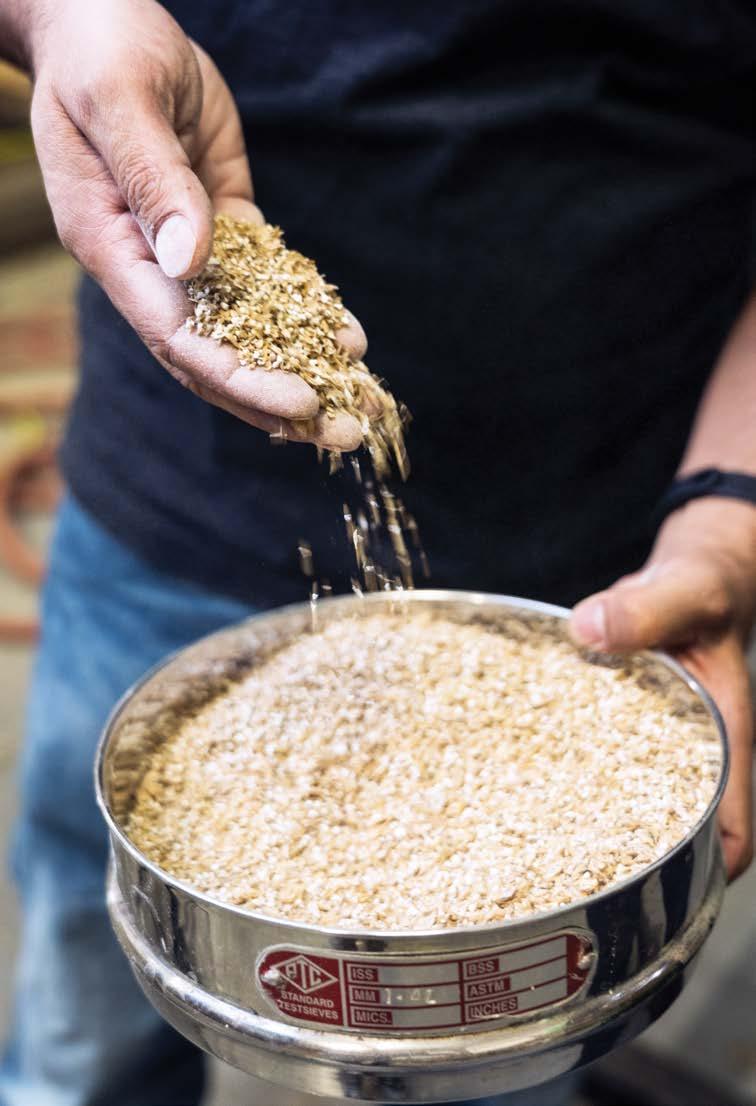
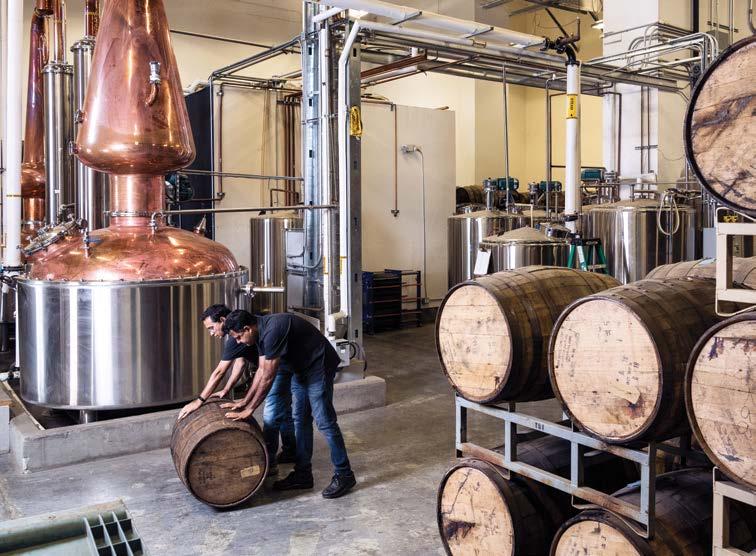




to grow. He also built some of his own prototypes to improve the process. At the distillery, he explains how the TechShop in San Jose was an incubator for these prototypes. “I like building stuff,” he says, “whether it’s software or electronics and hardware. Let me give you an example.” From behind a desk, he pulls out a hefty, complex-looking object made of metal and glass. It’s a shell and tube condenser, a device used to liquify alcohol vapors, and Saksena created it by hand at the now-defunct maker space.
When he and his business partner began to explore the business side of things, searching for a space that would accommodate the equipment and technical processes required of a distillery, they found an encouraging partner in the City of San Jose. “We talked to cities all over the Bay Area,” Saksena recalls. “Some said, ‘We want big software firms here, we don’t need this.’ But San Jose was very supportive; they were very open. They worked with us on the regulations. There are fire and zoning requirements…you can’t just go into an empty shell. Starting a software company is fairly easy: you rent space in an office park, and you can just do it. This was a complex project. It took us about a year just to find a place.”
The location they found (on South 10th Street) is in the warehouse district north of downtown that is also home to several of the new crop of craft breweries. These spaces are perfect for alcohol production, as they can store the large fermenters required in the process. The 10th Street space is huge but is already filling up, housing the vats of mash and wort, custom made copper stills, and, of course, stacks of barrels with whiskey aging inside.
Speaking of the aging process, any whiskey drinker must ask about the age of the bottle in question. Some take eight, ten, twelve years or more before they are bottled and shipped out to the public. But Saksena wanted something they could bring to market in a short timeframe. Although additional products are forthcoming, their currently available single malt (the only product on the market at the moment) only ages for about 14-18 months. And they have eschewed the workaround common in small-batch distilleries of using tiny barrels to extract the flavor more quickly. Instead, they focus on making a clean, flavorful product from the outset that doesn’t require extensive aging.
“People ask how long we age the whiskey,” Saksena says.
“My response is, ‘As long as it takes.’ ” He offers a taste of another product, not yet ready for consumption. It’s delicious, but with more bite than the single malt and no earthy peat flavor. His nuanced palette says it needs to wait. “This will stay in the barrel until it’s ready.” They have as many as five different varieties that are in various stages of the aging process.
They use a number of methods to produce the clean but flavorful effect they were looking for in their signature single malt, including fermenting the wort in open air for a period of time to allow local wild yeasts to do their work. This creates an initial beer that has a distinctly “San Francisco sourdough” flavor to it, which they carefully retain throughout the distilling. They also import specialty peated malts from Scotland, and the custom stills imbue the whiskey with maximum taste while still cutting out the harsh alcohols.
“We knew what we wanted to do—we wanted to create a world-class single malt. There are global single malts coming out, but what is happening here in America is that most of the single malts taste more like a bourbon than a single malt; the complex nuances don’t shine through. But we wanted to bring those out. We wanted to
create a smooth, complex, and clean product.”
Their single malt whiskey is currently available at several South Bay bars and restaurants, including Paper Plane, Haberdasher, and Alexander’s Steakhouse—and bottles can be found at some markets and liquor shops that carry local products. And while the distillery does not yet have a permit for a tasting room, private tours are available for groups by appointment.
Saksena is clearly proud of and passionate about his whiskey, and the fact that he could make it in his home city of San Jose means even more to him. He makes efforts to involve the community, recycling the grain for use by local farmers and working with small local businesses to distribute. “I wanted to do something which allowed me to work with my local community. It’s something which was missing [in software], and I wanted to get back to—not working across four time zones, but something grounded in the community.”
So, next time you get a chance, take a seat at your local bar, order a shot of 10th Street whiskey, and enjoy a uniquely San Jose flavor. It’s worth savoring. C
With an elevated highway wrapping around Veggielution, entering into this community farm feels a little like stepping into the eye of a hurricane. The urban sound of rushing cars fades to white noise, and the rows of crops firmly take center stage.
“Veggielution is an oasis in the middle of the city,” affirms Yazmin Hernandez Carbajal, the nonprofit’s community engagement manager, “I think it’s the perfect combination of community and nature.” It’s the middle of a weekday at the farm and right now all is quiet. Yazmin— hose in hand, curly hair swept into a messy bun—is taking a break from handling offsite and onsite events to water the wisteria dome.
Though the plants grow uninterrupted this afternoon, they receive a considerable number of visitors the first Saturday of each month. At a quarter to
nine, this day commences with yoga at the outdoor pavilion. Flowing through vinyasa poses alongside the stretching limbs of sunflowers and corn stalks allows people to peel away urban worries and slip into a replenishing mindset.
The currently hushed Cocina (“kitchen” in Spanish) fills with sounds of students chopping veggies and called instructions from East San Jose–based chefs and home cooks, all working toward seasonally-centered, culturally-relevant recipes. The surfaces of the picnic benches, now empty save for a solitary googly eye, become covered with arts and crafts projects. The farm stand’s closed doors open and freshly harvested veggies are deposited into large bins. The vacant youth garden floods with enthusiastic youngsters and their guardians, everyone wielding wheelbarrows and watering cans.
In this fenced-in part of the farm, kids learn about agriculture, pull weeds amid its beds and trees, and carry greenhouse sprouts to be transplanted in their new home. “I don’t think a lot of kids know how food grows,” Yazmin says. “I think it’s a ‘wow’ moment for them when they pull out a plant and… there’s potatoes all over!”
Veggielution first took root over a decade ago when three San Jose State students recruited homeowners around the campus to lend their front and back yards with the mission of bringing people together through environmental stewardship. Eventually, after stumbling on an empty six and a half acres of parking lot at East San Jose’s Emma Prusch Farm Park, they gained permission to transform it into the community farm it is today.
Yazmin’s own journey carried her in unexpected direc-
Written by Johanna Hickle
Photography by Sannie Celeridad
Veggielution
647 South King Road San Jose, CA 95116 veggielution.org Social Media veggielution
“Veggielution is an oasis in the middle of the city.”
–Yazmin

Community Engagement Manager


tions. As a child, she experienced a harsh reality in Ciudad Juarez, Mexico, a city suffering significant sex trafficking and financial hardship. She survived a kidnapping attempt at 9, another at 10. After coming to the States, she initially struggled finding where she fit into the community. “But when I came here to Veggielution, everything got a little more aligned,” Yazmin says. “I felt a lot more supported in my immigration status.”
She fondly recalls first discovering Veggielution when her “hippy-ish, environmentally-driven” friend dragged her along to one of the Cocina classes. That day, Montserrat Ayala (owner of Vitamina Juices & Blends and a fellow immigrant) taught how to make Aztec Tor-
tilla Soup. When Yazmin asked how she could get involved, she was offered the instructor position for the following month’s class. “I was like, ‘Hell yeah!’ I made basmati rice and middle eastern-oriented veggie kababs with yogurt sauce.”
Determined to make this her community, Yazmin regularly volunteered until she joined the staff full-time.
Among her other duties, Yazmin coordinates Veggielution’s Eastside Grown, a training program for local food entrepreneurs to provide training and mentorship as well as connect them with residents and resources. Fellows of the program help work Veggielution’s food carts deployed at events across the city.
Eastside Grown and Veggielution’s other offerings show that people, like plants, grow best when specific conditions and environments are met. When nourished by a welcoming community, when provided with a healthy dose of nature, and when enveloped in a new sphere that engages in ways that school, work, and home don’t, individuals blossom. It’s a space of self-care that will enable community members to root out the stresses of the everyday, plant moments of rest, and turn their faces toward the sunshine. “Come and visit!” Yazmin extends a personal invitation. Come and visit this place that cultivates the potential of both people and plants. C
#ContentPick
09
Speed City: From Civil Rights to Black Power Former San José State sprinters, Ray Norton, and Bob Poynter share their personal experiences as part of exhibit, Speed City. Exhibition 11/1/19–4/5/20 11/6 12–1pm Lunchtime Lecture sjmusart.org/speedcity
Iris Chang Park Grand Opening
Celebrate the opening of San Jose’s newest park and the dedication of its powerful public artwork “The Power of One.”
11/9 Epic Way, San Jose 10-11:00am sanjoseculture.org
12
Well-RED poetry readings
Caesura release party
Regional poetry journal release party with readings from the poets.
11/12, 7pm Works/San José pcsj.org
12
BoundarySpan
Featuring work by Michael Arcega, Jimin Lee, Paula Levine, Sherwin Rio, and Desiree Rios that subverts notions of boundaries. 11/12-2/21/20 Natalie and James Thompson Art Gallery gallery.sjsu.edu
MON 7PM–9:30PM
Red Rock Open Mic Night
A family-friendly open mic experience that welcomes people of all talents to share and perform their art. Red Rock Coffee redrockcoffee.org
TUES 7PM–10PM
Caffe Frascati Open Mic
Open Mic Night! All styles welcome. Happy Hour all night.
Caffe Frascati caffefrascati.com
14
16
“The Wickhams: Christmas at Pemberley” Two seasons ago, audiences were charmed by the “Pride and Prejudice” sequel “Miss Bennet: Christmas at Pemberley.” In a new companion play, the servants navigate their own comedy of manners.
11/14-12/15 City Lights Theater Company cltc.org
Autumn Art Fair
Fall fundraising event with artist open studios, holiday gift bazaar, family friendly activities and cornhole tourney. 11/16, School of Visual Philosophy, 1-6pm schoolofvisualphilosophy.com
17
17
ICA: Sense of Self
In the hyper-saturated age of portraits and selfies, Bay Area Photographers remind us of the enduring power of photographic portraiture. Exhibition 11/9–3/15 11/17 Reception San Jose ICA sjica.org
Triton Museum: FLIGHT Artist Deborah Oropallo employs photomontage as a strategy for visualizing how media-based images accumulate and overwhelm our collective consciousness.
11/17 2-4pm Reception Triton Museum of Art tritonmuseum.org
19
SPUR’s Drink and Discourse with Matt Mahood of SVO
Grab a drink and conversation with the president and CEO of the Silicon Valley Organization about the health and future of the region’s economy.
11/19 6pm SPUR San Jose spur.org
22
This original Southern California Punk/Surf power trio is one of only a handful of bands who have been continually active since the earliest days of the West Coast Punk Scene 11/22 8pm / 21+ The Ritz theritzsanjose.com
WED 9PM
The Caravan Lounge
Comedy Show
Comics from all over the Bay Area and the world perform, hosted by Ato Walker. The Caravan Lounge caravanloungesanjose.com
WED 9PM -1AM
Wax Wednesday
Every Wednesday we feature a different group of local vinyl-only DJ’s playing records from across the musical spectrum. Cafe Stritch cafestritch.com
THURS 9PM
The Changing Same
This excursion keeps time with the future of soul, R&B, and jazz through guest DJ sets and live performances. The Continental Bar thecontinentalbar.com
FRI 8PM
Comedy Sportz
The award-winning interactive comedy show where two teams of players compete for laughs and points.
3Below Theaters and Lounge cszsanjose.com
29
A Merry-achi Christmas
Mariachi Sol de Mexico’s musical tribute to Mexico’s Christmas traditions is a festive start to the holidays.
11/29 Hammer Theatre, 3:00 & 7:30pm hammertheatre.com
07 Storm Large
The Pink Martini singer and Rock Star: Supernova finalist performs American Songbook at 7:00 and her racier Unbuttoned at 9:30.
12/7 7:00 & 9:30pm Hammer Theatre hammertheatre.com
05
You/Emma by Pardo Paz
A one-woman show called “a postmodern fever dream of Madame Bovary.”
Dec 5-15 Pear Theatre thepear.org
07
Works San Jose Benefit Art Auction
Start or grow your collection with 100 regional artists in Silicon Valley’s most eclectic and affordable art auction.
Auction night: 12/7, 6pm Works/San José workssanjose.org
10
Well-RED poetry readings
Red Wheelbarrow release party
Regional poetry journal release party with readings from the poets.
12/10, 7pm Works/San José pcsj.org
13 The San Jose Nutcracker
A classical holiday ballet presented featuring historical references to the heritage that has made Santa Clara Valley.
12/13-24 Hammer Theater newballet.com
DAILY (Begins Nov 15)
Downtown Ice Skating
It is the only rink in the world that offers skating in and around a circle of 32 palm trees. Outside of SJ Museum of Art downtownicesj.com
3RD TUES 7PM–10PM
Two-Buck Tuesday
The gallery hosts $2 art sales, along with a combination of performances, live painting, and/or art-making activities.
KALEID Gallery kaleidgallery.com
14
15
San Jose Craft Holiday Fair
Join San Jose Made and hundreds of makers, artists, designers, food producers, and emerging brands for this year’s holiday makers fair. Indoors. Free Admission. All Ages. 12/14 & 1/15 11am-5pm South Hall Downtown SJ sanjosemade.com
Santa Run
Wear your ugly sweater, dress up as Santa, or even create your own holiday outfit. This 5K run and walk will bring joy to your soul.
Registration required 12/15 225 West Santa Clara Street bit.ly/santarunsv
17
17
Broadway San Jose: Waitress
The story of Jenna, an expert pie maker who dreams of a way out of her small town. A baking contest and the town’s new doctor may offer her a fresh start, but Jenna must summon the strength to rebuild her own life. 12/17-12/22 Center for the Performing Arts sanjosetheaters.org
Carols in the California
The Symphony Silicon Valley Chorale presents a traditional sing-along of your favorite carols with choir and brass ensemble, and dazzled by performances of classical works. 12/17 7:00pm California Theatre symphonysiliconvalley.org
18
Content Pick-UP Party 12.0
Celebrate eight years of featuring the localcreative culture with the artist’s work displayed, live music, and holiday cheer.
12/18 7:00pm-9:30pm Method 42 content-magazine.com
31 Noon Year’s Eve
The countdown to midnight may belong to the adults, but come celebrate the arrival of 2020 with a family friendly celebration.
12/31 12pm Happy Hollow Park & Zoo happyhollow.org
*Events are subject to change. Please confirm event details with the presenting organization or venue.
DAILY (Nov 29 thur Jan 5)
Christmas in the Park
An annual family holiday tradition that takes place in the heart of Downtown San Jose. Plaza de Cesar Chavez. christmasinthepark.com
2ND WED 8PM-10PM
Cafe Lift Open Mic + Canvas
Play music and/or create a painting. Or, enjoy a cup of coffee and music with friends.
GateWay City Church cafeliftsj.com
1ST FRI 7PM-11PM South First Friday Artwalk
Self-guided, nighttime tour of galleries, museums, and creative spaces featuring eclectic art exhibitions and performances. SoFA District southfirstfridays.com
2ND SAT 5PM–8PM
Songwriter Saturday Showcase
Coffee is served while local songwriters perform.
Crema Coffee #3 facebook.com/ songwritersaturday
The production of CONTENT MAGAZINE would not be possible without the talented writers, editors, graphic artists, and photographers who contribute to each issue. We thank you and are proud to provide a publication to display your work. We are also thankful for the sponsors and readers who have supported this magazine through advertisements and subscriptions.
Be a part of the CONTENT community.
Contact us at: Editor@content-magazine.com

SANNIE CELERIDAD
Sannie is a San Jose native with an obsession for coffee, sour gummy worms and classic BMWs. His passions are building relationships and documenting people and their everyday lives through photography.
instagram: prsvere
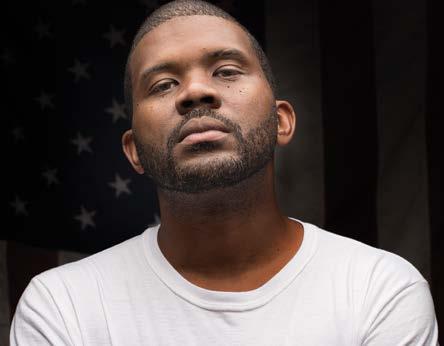
DEMONE CARTER
Demone is an award-winning artist, educator, and social entrepreneur from San Jose. Performing under the name DEM ONE, he has released several albums and was named a 2016 Silicon Valley Artist Laureate.
instagram: lifeafterhiphop

NGOZI HARRSION
Ngozi is a creative and photographer using data, design, and photography to build brands and tell stories. His work primarily includes portraiture and documentary.
instagram: andgosee

GEGE XU
A Chinese-American award-winning filmmaker, photographer, and painter. She is the founder of Gege X Media, a production company specializes in wedding and event documentary. Her work emphasizes the beauty of individuality and intimacy.
instagram: gegexuart

BRAD SANZENBACHER
Brad is a public relations professional and folksinger from the Santa Cruz mountains. His machine has not yet killed a fascist, but it will never stop trying.
instagram: bradsanzfolk

MICHELLE RUNDE
Part-time writer, full time tech worker, Michelle spends her free time with her partner, dog, and cat. She is always cooking up vegan recipes, listening to audiobooks, and enjoys going to the gym whenever possible .
instagram: michrun13

NATHAN ZANON
Nathan has called San Jose home since the turn of the century. He works in social media, devotes much of his time to nonprofits, and is an advocate of the arts, community activism, and great movies. If possible, he would like to take a photograph of your dog.
instagram: nathanzzzzzzz

AVNI LEVY
Avni is a multimedia storyteller and Silicon Valley native. She’s passionate about using photos and video to showcase entrepreneurs, uncover personal stories, and stalk Boba, her fluffy black cat.
instagram: glasslocketfilm
Resident Ballet Company of the Hammer Theatre
The San Jose Nutcracker
December 13-24
Fast Forward
March 28
Swan Lake
May 16-17


SVCREATES recognizes the region’s finest artists who have demonstrated a commitment to developing their art forms and to enriching our community with exhibitions, performances, presentations, and service. The SVArts Award Program, including the SVLaureates, awards unrestricted cash prizes to support artists while they pursue their creative work.

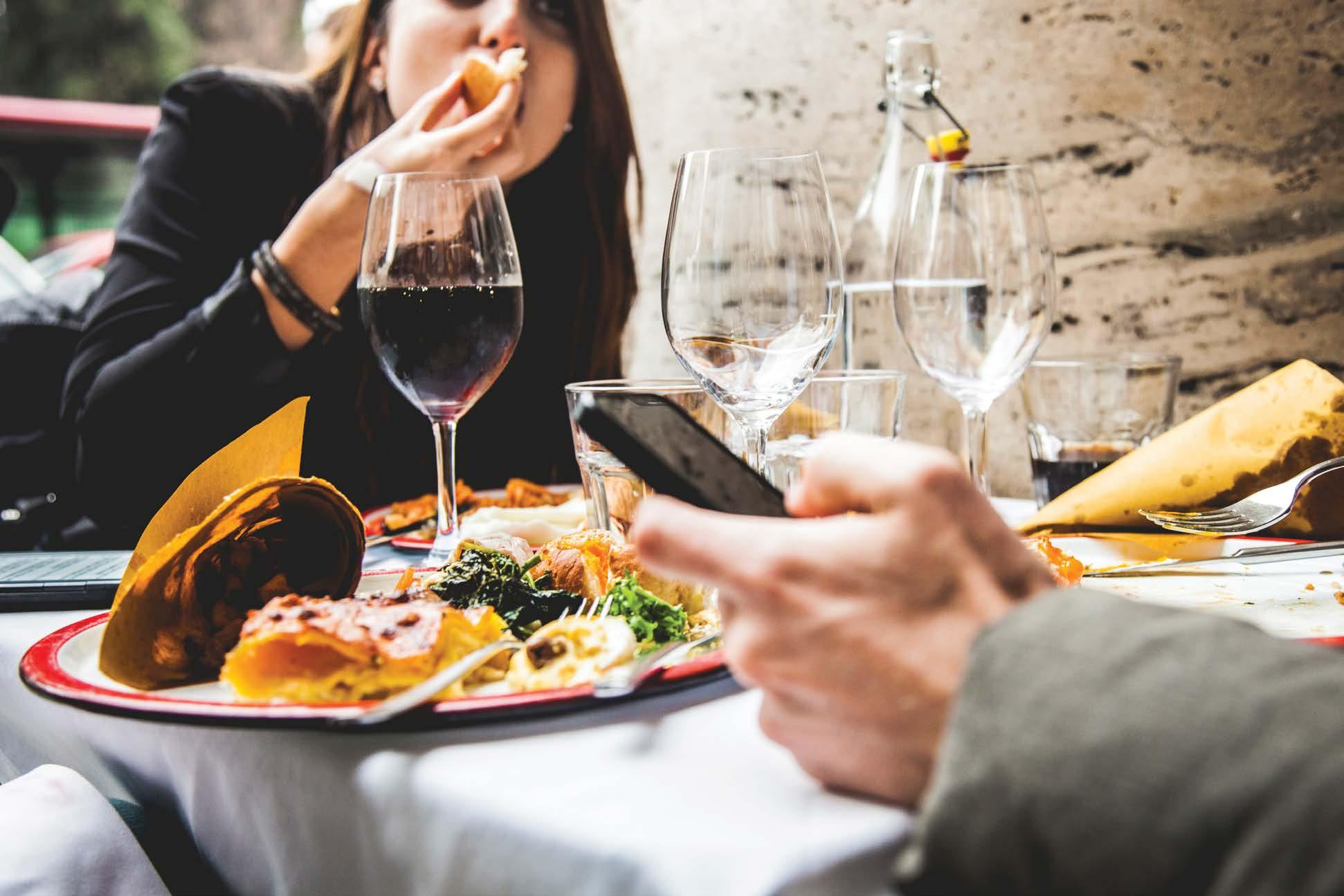





DREAMS OF THE SALT MARSH is a 240’ ceramic bas relief mural that enhances the new Alviso Storm Pump Station at the corner of Gold and Catherine streets. The City of San José Office of Cultural Affairs Public Art Program worked with bay area artist Sam Tubiolo and the Alviso community over a four year process to render thousands of years of history into a visual mosaic timeline.
